19 Things to Do in Katowice – Poland’s Historic Mining City
The capital of the Upper Silesia region, Katowice rarely makes it to the list of places to visit in Poland. However, it is an excellent example of a thriving urban change with vibrant attractions, historical heritage, and dynamic city life. With plenty of delightful things to do in Katowice, the city is a true gem among the cities I’ve been to.
This off-the-beaten-path destination, with an up-and-coming city vibe, is entirely different from the other Polish cities you might have visited. With no medieval market squares like in Krakow, Warsaw, Poznan, Gdansk, Gniezno, or Wroclaw, featuring beautiful tenement houses or vast river canals and boulevards like in Bydgoszcz, Katowice’s appeal lies in its cultural and historical heritage of being an industrial city of coal mining.

Precisely, this coal mining heritage should be the reason to visit Katowice as the city has changed drastically, embracing its history and turning it into a tourist attraction.
I love cities with gorgeous preserved architecture, but the most surprising and inspiring was seeing the remains of its history repurposed and revived. Here, decommissioned mining shafts and abandoned factories are turned into cultural centers, galleries, or museums.
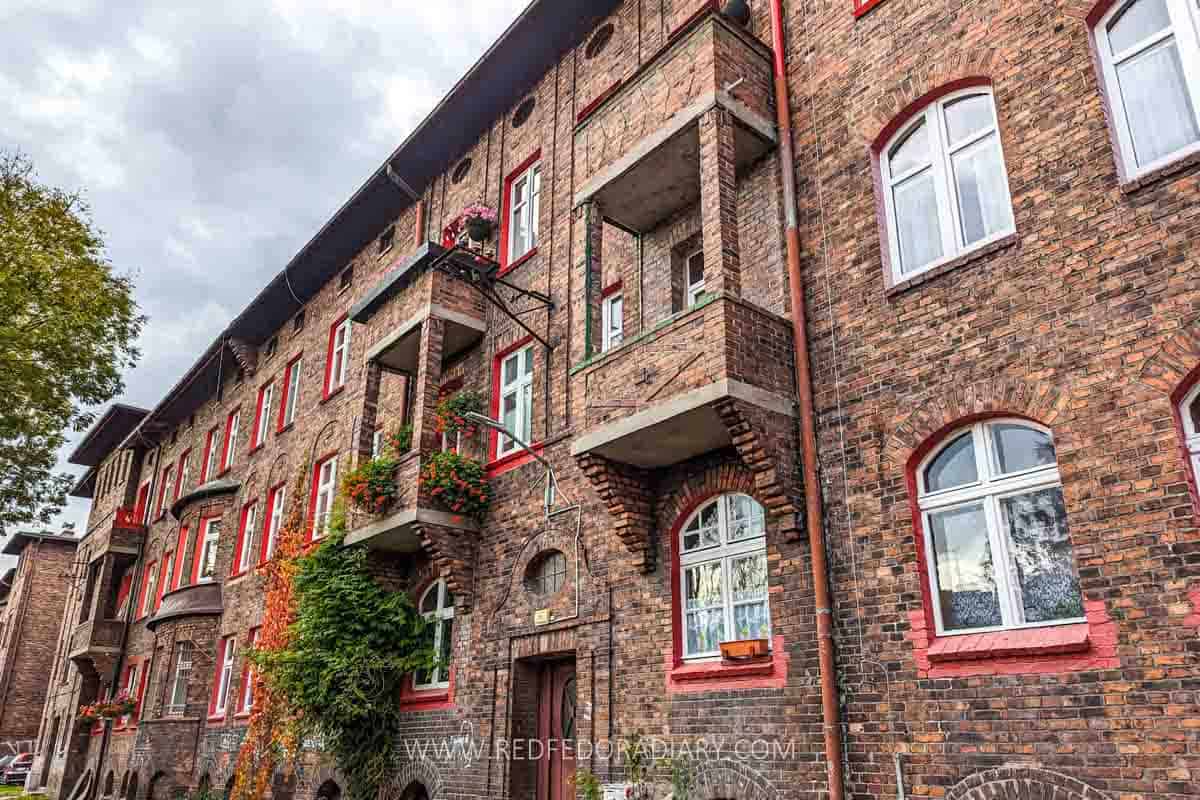
Equally inspiring was wandering through the streets of Katowice’s old mining neighborhoods, admiring Modernist architecture, hunting down its neon heritage signs, trying regional cuisine, and popping into its trendy cafes and coffee shops.
This detailed Katowice travel guide provides a list of amazing things to do, restaurant and hotel recommendations, and travel tips when visiting Katowice city as a day trip from Krakow or spending a few days to immerse yourself in its industrial heritage fully.
Katowice Travel Essentials
Book a flight: I use Skyscanner or WayAway. The latter also offers cashback with its Plus membership. Read more here.
Reserve a hotel: I use Booking.com to book my hotels or apartments.
Find best-suited tours: book your activities on Viator or Get Your Guide.
Rent a car: DiscoverCars is one of the best car rental aggregators with a wide choice of vehicles.
eSIM: I use Airalo eSIM whenever I travel. Get 3 USD with code: BAIA2592.
Travel insurance: SafetyWing is my go-to travel insurance covering COVID. Now, they have add-ons for adventure sports coverage and electronics theft.
Disclaimer
This post includes affiliate links to products, which earn me a small commission at no extra cost to you. This helps to fund my blog and bring more authentic articles to you 🙂 Learn more
Why is Katowice worth visiting?
Despite its architectural and cultural rebirth, Katowice is still an underrated and less-visited destination in Poland, unlike its neighbors – Kraków and Wrocław.
Unlike most bigger Polish cities, Katowice was not created as a medieval town. It was founded as a farming village in the 13th century that later expanded by combining various towns, villages, and industrial worker estates throughout its history.
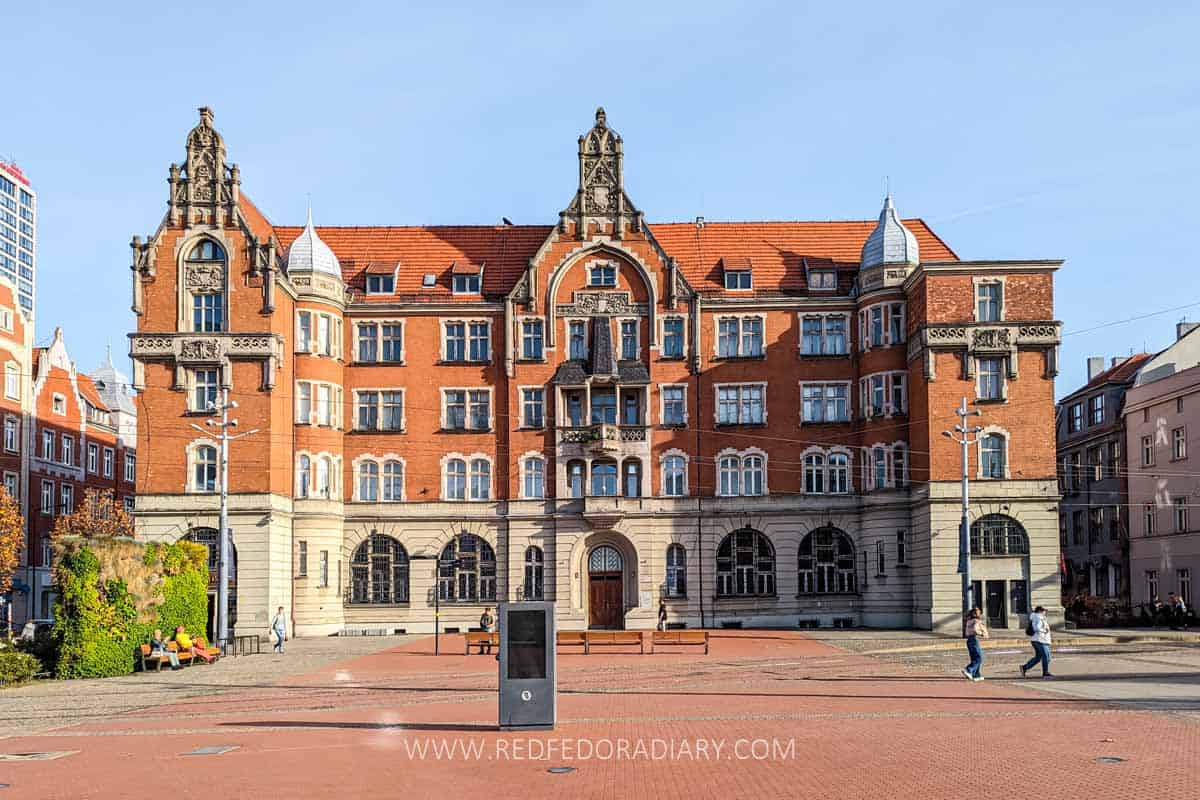
Therefore, you won’t find a Katowice castle, palaces, ancient ruins, or medieval-looking Katowice old town here. Instead, the city offers some of the most mixed, odd, and exciting museums and landmarks, making it one of the unique Polish cities as it doesn’t follow a cut-out template of European tourist destinations.
Being part of the former empires dominating the continent in different centuries, including Nazi Germany and the Soviets in the 20th century, Katowice was the hub of the three famed Silesian Uprisings, showing the resilience and fighting spirit of the locals.
The influence of its domineering empires is evident in its current mix of architectural styles, from Modernist to Communist Brutalism and red-brick heritage houses. At the same time, the region’s strong sense of independence is visible through them.
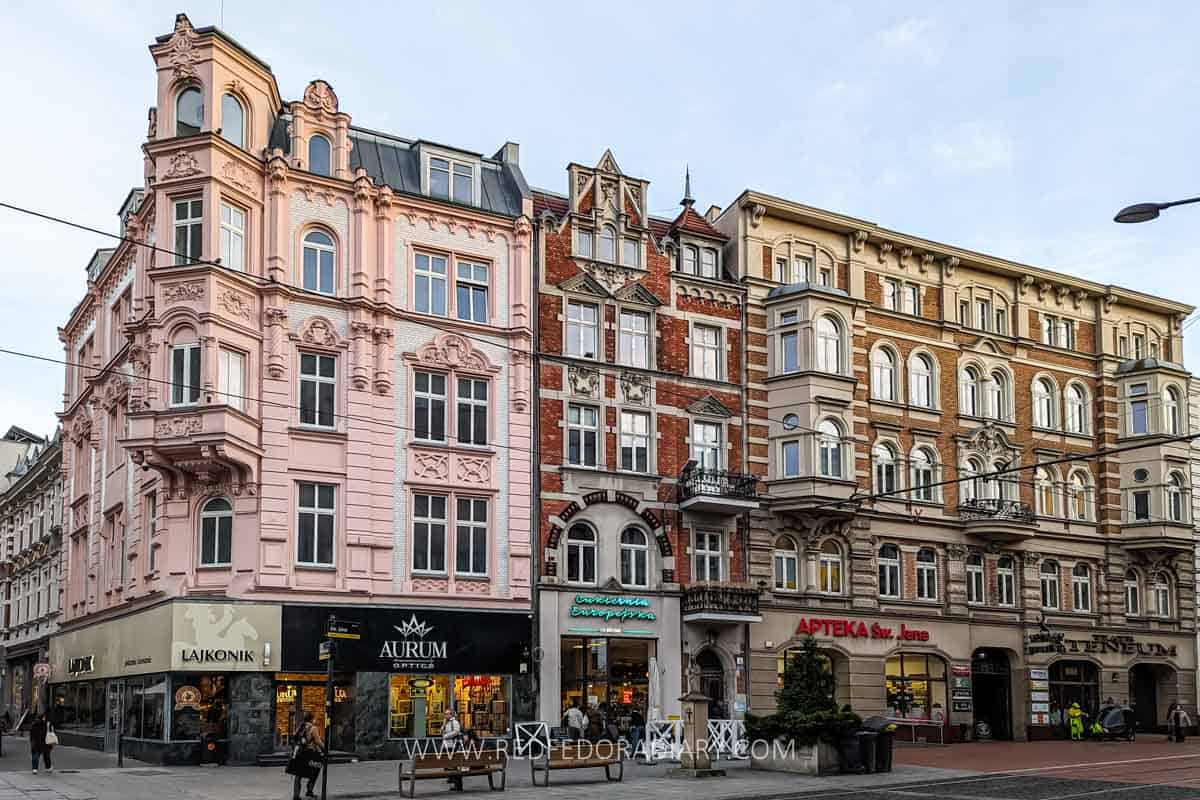
Unlike Warsaw, the city was not destroyed during World War II. However, the Nazis did demolish lots of historical monuments, renamed streets with German names, and exiled many Jewish and Polish populations.
When the Soviets came to Poland, many buildings around Katowice Rynek Square were destroyed to make room for communist architecture and concrete monuments. But if you wander through the backstreets, you’ll find beautifully decorated buildings from the late 19th century.
The city became a cultural and business center in the post-communist era. In the past decade or so, it underwent a massive revitalization process, resulting in a complete transformation. If Katowice tourism was almost non-existent in the past, it is changing today.
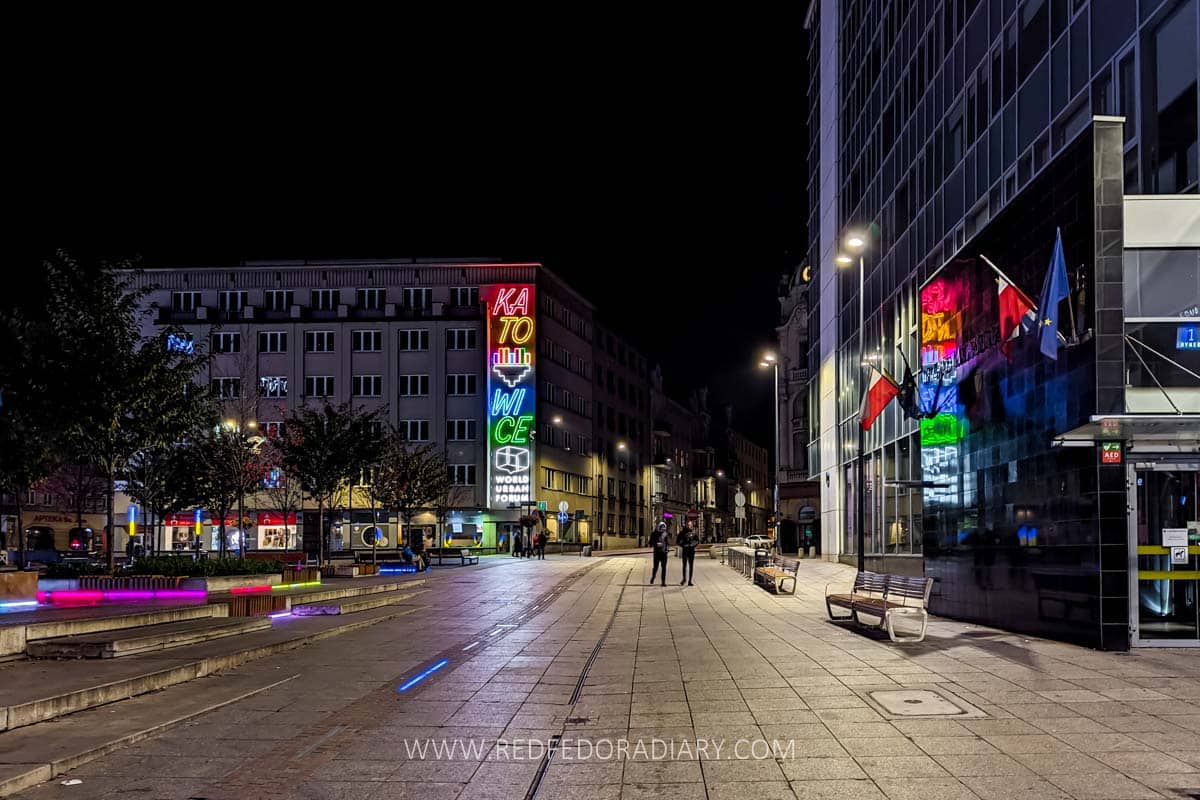
Moreover, Katowice Airport serves budget-friendly airlines from all across Europe, making it a great base to explore Poland or visit neighboring countries such as Czechia (Czech Republic) or Slovakia.
Katowice things to do map
For a more comfortable way of exploring the city, here is the Google Maps list of all the things to do in Katowice for you to save and use whenever you need it. If you download the area for offline use, you will not need the data to access the spots
Amazing things to do in Katowice
Start the morning with a tasty breakfast
Katowice has a dynamic coffee scene with cute cafes spread along its streets. Black Woolf, located on 3 Maja Street, one of the city’s central streets, is perfect for a delicious coffee and a hearty breakfast.
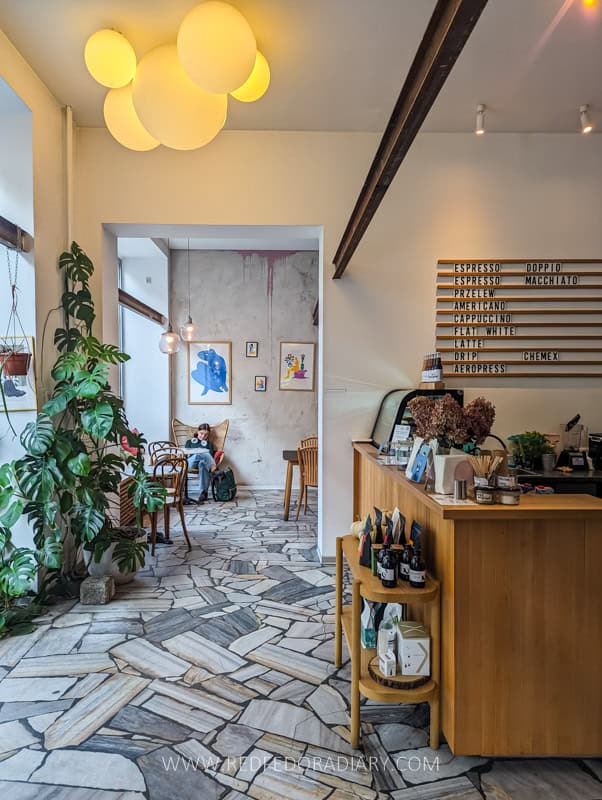
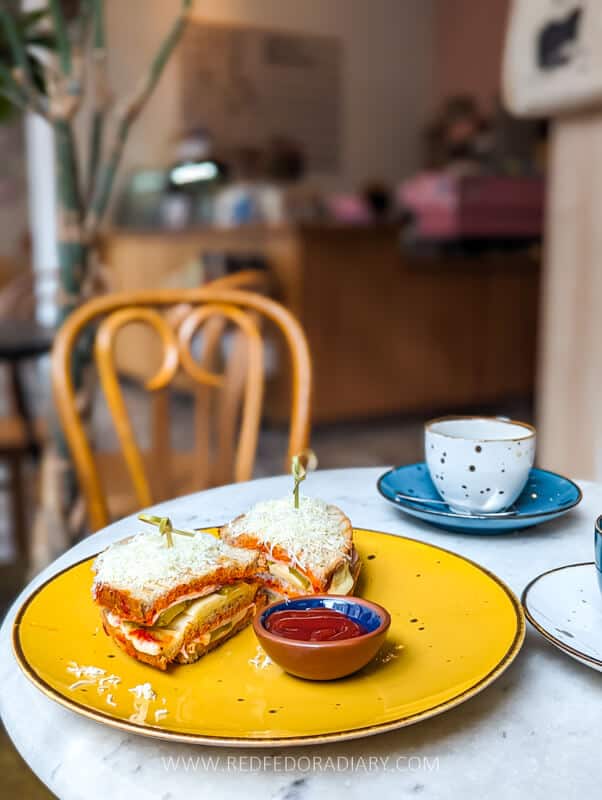
The cafe is a local favorite, with colorful walls, comfortable furniture, charming interior decorations, and a relaxed atmosphere. The cafe has a huge bookshelf of many English books and magazines you can grab and read while sipping coffee or tea.
I opted for their Polish Balkans toast – a classic bacon and cheese toast with ajvar spread and pickled cucumber. The toast had three slices of bread, lots of cheese inside and outside, and a generous spread of the sauce, making it very filling that kept my hunger at bay until slightly late lunch.
Explore Market Square and nearby backstreets
Once you finish breakfast, one of the following things to do in Katowice is walk on 3 Maja Street towards the city’s Market Square (Rynek) and wander through its backstreets, admiring different architectural styles.
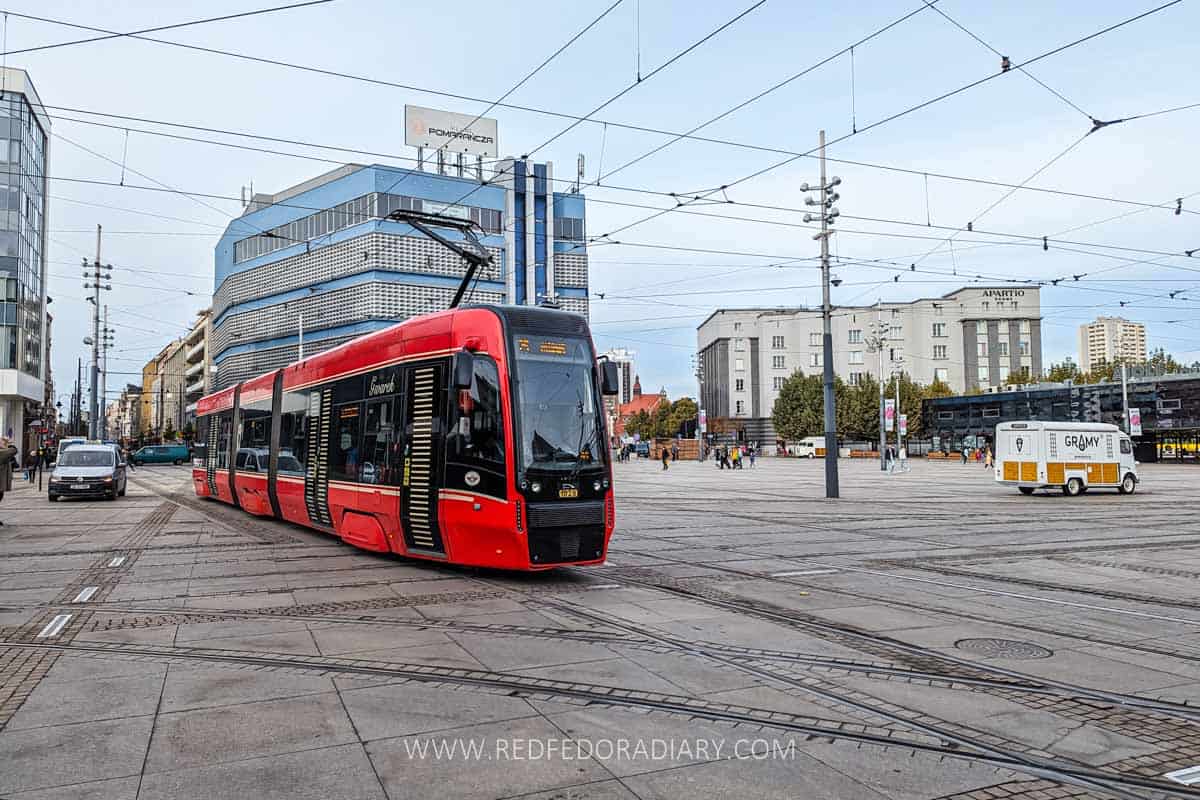
Developed in the mid-19th century, Katwoice’s Market Square is very different from the other similar plaza-like areas you might have seen in other cities of Poland.
The square, encircled with Neo-Renaissance, Neo-Baroque, Neo-Gothic, Neo-Romanesque, and Art-Nouveau style buildings in its backstreets primarily built during the Prussian rule, and post-war Modernist structures from the communist times, is crossed by various tram lines, making it the very heart of the city.
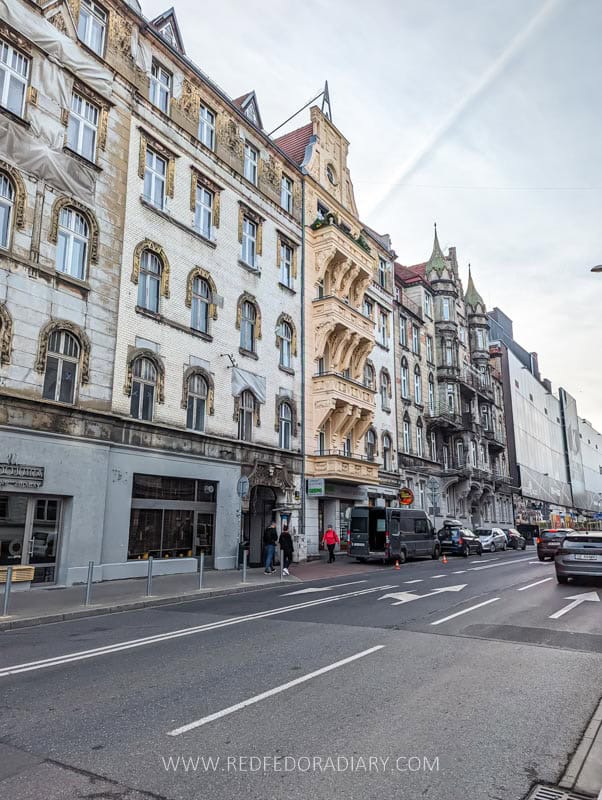
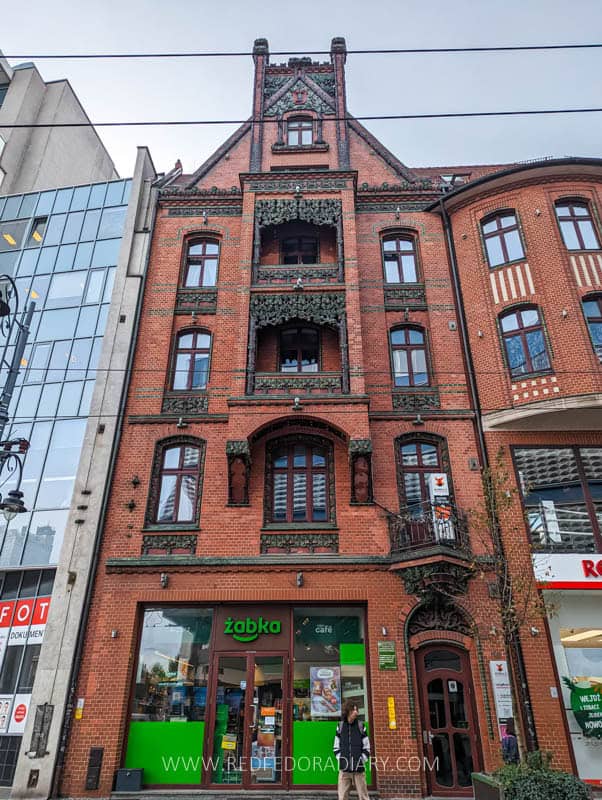
Before you reach the square, notice a gorgeous building adorned with oak tree brunches and oaknuts at No.6/8 3 Maja Street. It also has a high boot in its central roofing decoration.
This pedestrian flat area underwent a massive overhaul in the 2010s and now features deck chairs, scattering flower pots and trees, and a flowing river.
Formerly known as Friedrichsplatz during the German occupation and as Stalina Square during the Soviet era, the current square actually incorporates three separate courts: Obroncow Katowic, Teatralny, and Kwiatowy.
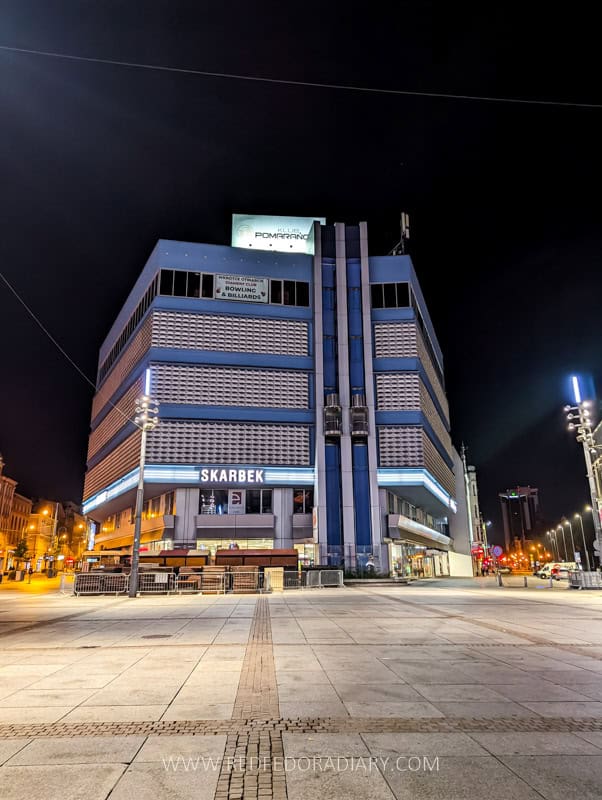
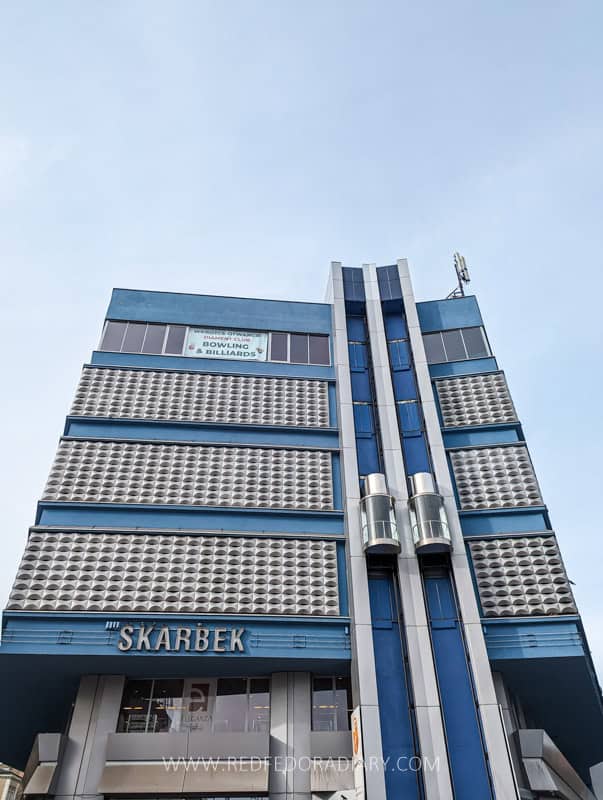
The very center of the Rynek has two impressive Soviet-era buildings – Skarbek Cooperative Department Store, constructed in 1975, and Zenit Cooperative Department Store in 1962. I especially loved the Skarbek with its white-and-blue facade and external elevators. It is even more incredible at night with its own neon light illumination.
A few steps away from Skarbek is another marvelous building of Neo-Renaissance style – Hotel Grand, built in 1920 that used to house the Silesian Museum from 1984 to 2015. In front of it, you’ll also find a Monument to the September Scouts, honoring those who protected Katowice against Nazi occupation in 1939.
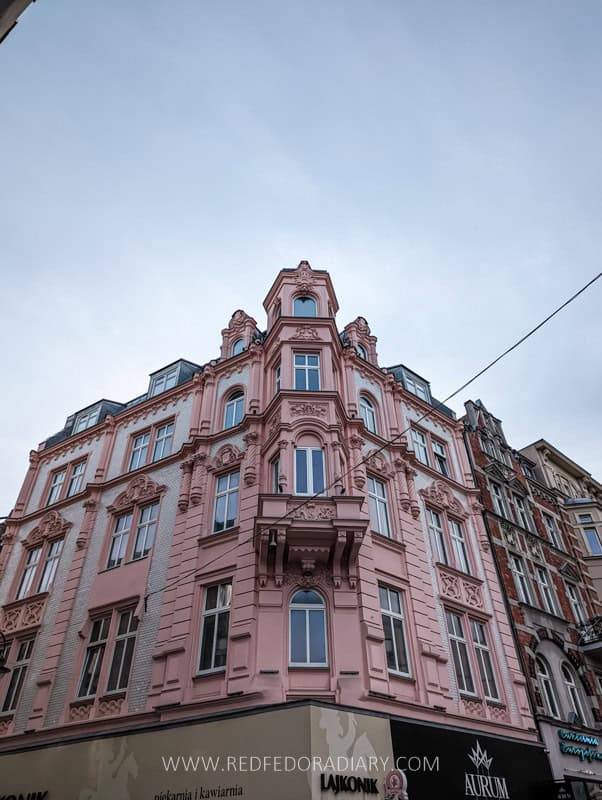
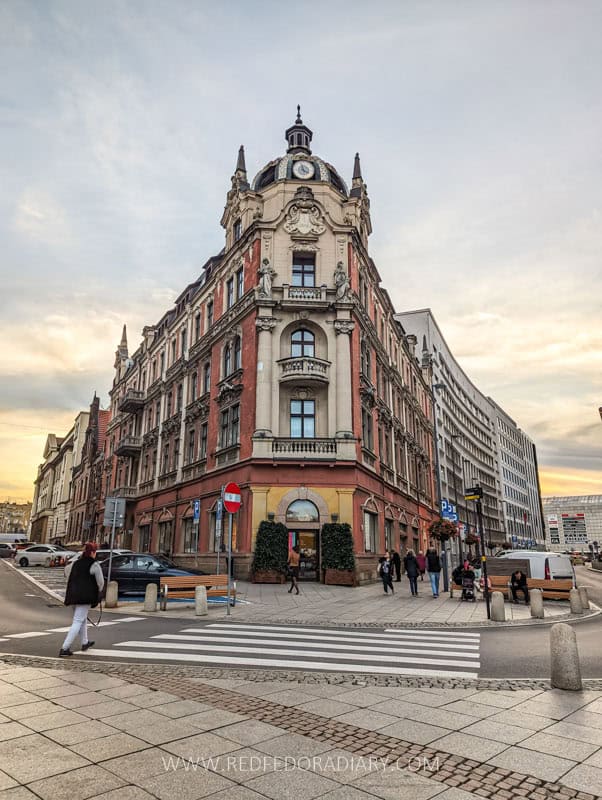
If you love the preserved architecture of the bygone centuries, one of the things to do in Katowice would be to walk through Dworcowa, Rynek, Mlynska, and Pocztowa streets to find hidden beautiful Art-Nouveau, Neo-Renaissance, and Neo-Gothic buildings.
If your trip to Poland is in winter, this Market Square is where Katowice holds its annual Christmas Market.
Admire the neo-Gothic school
3rd Secondary School, named after Adam Mickiewicz, is a gorgeous neo-Gothic building only a few minutes walk from the Rynek. This historic school, constructed in 1898–1900, was intended for a Junior High School established based on a German secondary school.
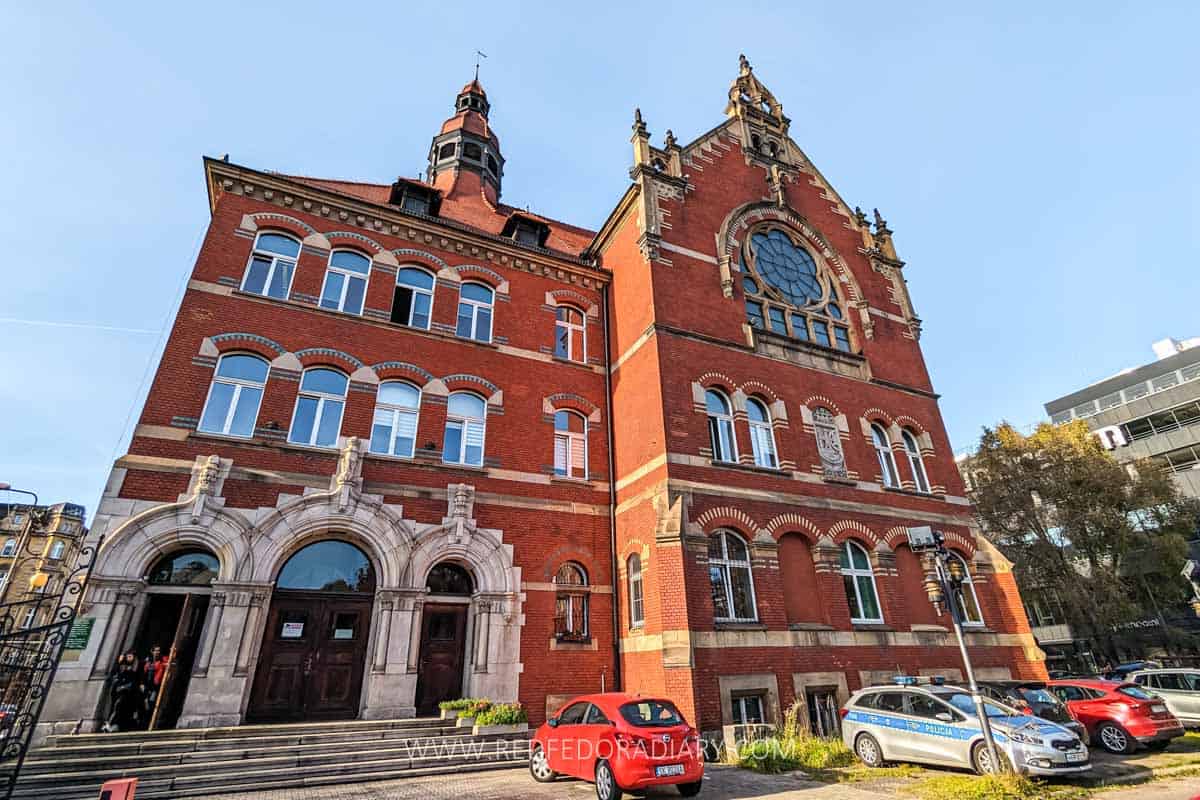
Besides being a beautifully ornate red brick building, it is also noteworthy to know that next to the school, there once stood the equally gorgeous Great Synagogue of Katowice and city baths, deliberately burned down by Nazis after their occupation.
Stroll down Mariacka Street day and night
Maricka, nestled only a 5-minute walk from the Rynek, is a lively 378-meter-long street created in 1875. This pedestrian street extends three city blocks before finishing at St. Mary’s Church, giving it its name.

After the transformation of the Market Square, Mariacka also underwent a renovation to have more modern aesthetics with new lamps and benches. Lined with cafes, bars, and restaurants, Mariacka Street has two different vibes during the day and as the sun sets.
It is calm, charming, and clean during the day, and it becomes a hub for local youngsters to party and have fun in the evening. Therefore, one of the things to do in Katowice at night is to experience local nightlife at one of its busy bars.
Hunt down street art in Katowice
Like other cities I’ve visited, Katowice has its fair share of murals and street art. This large and colorful painting allows you to understand the city’s rhythm and know more about it through this art form.
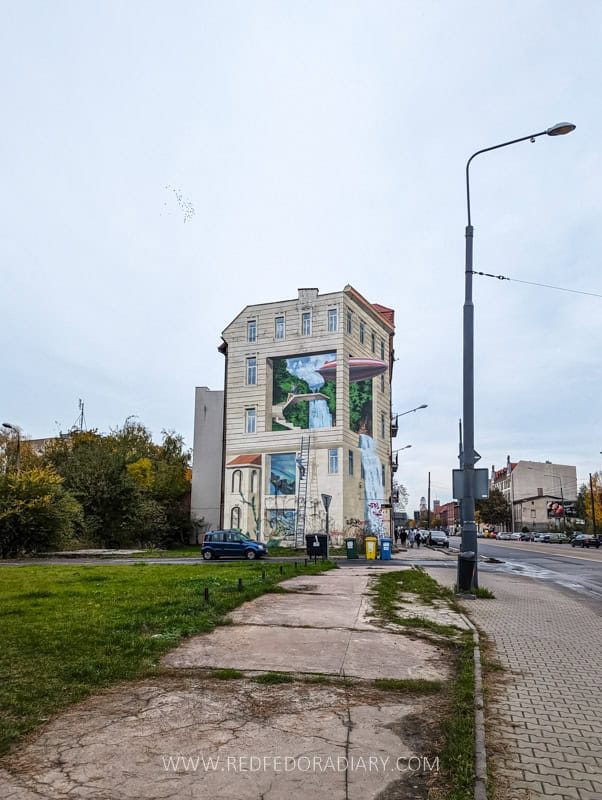
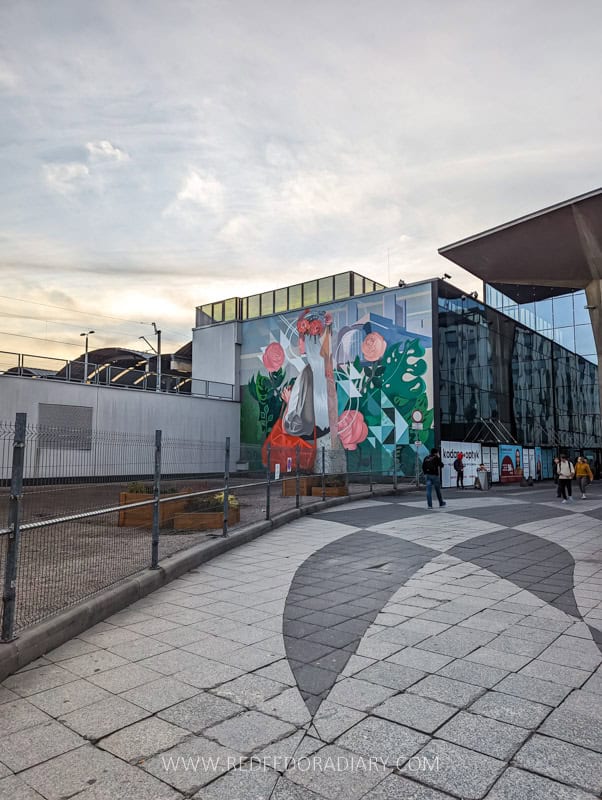
Finding these murals is one of my favorite activities in any city I visit, as they take you to the corners you might not walk through otherwise. My map above includes some of the most fascinating spots for street art in Katowice.
Have a dessert or lunch break
3 Sisters Bagel and Coffee (3 Siostry Bajgiel I kawa) is another excellent choice for a quick break for dessert and coffee in Katowice or a delicious and filling lunch.
As the name suggests, the main focus here is bagels, freshly baked on the spot, offering various choices and ingredients in its bagel sandwiches. Those who want something different opt in for breakfast with classic egg-based meals, toats, or baked potatoes, to name a few.
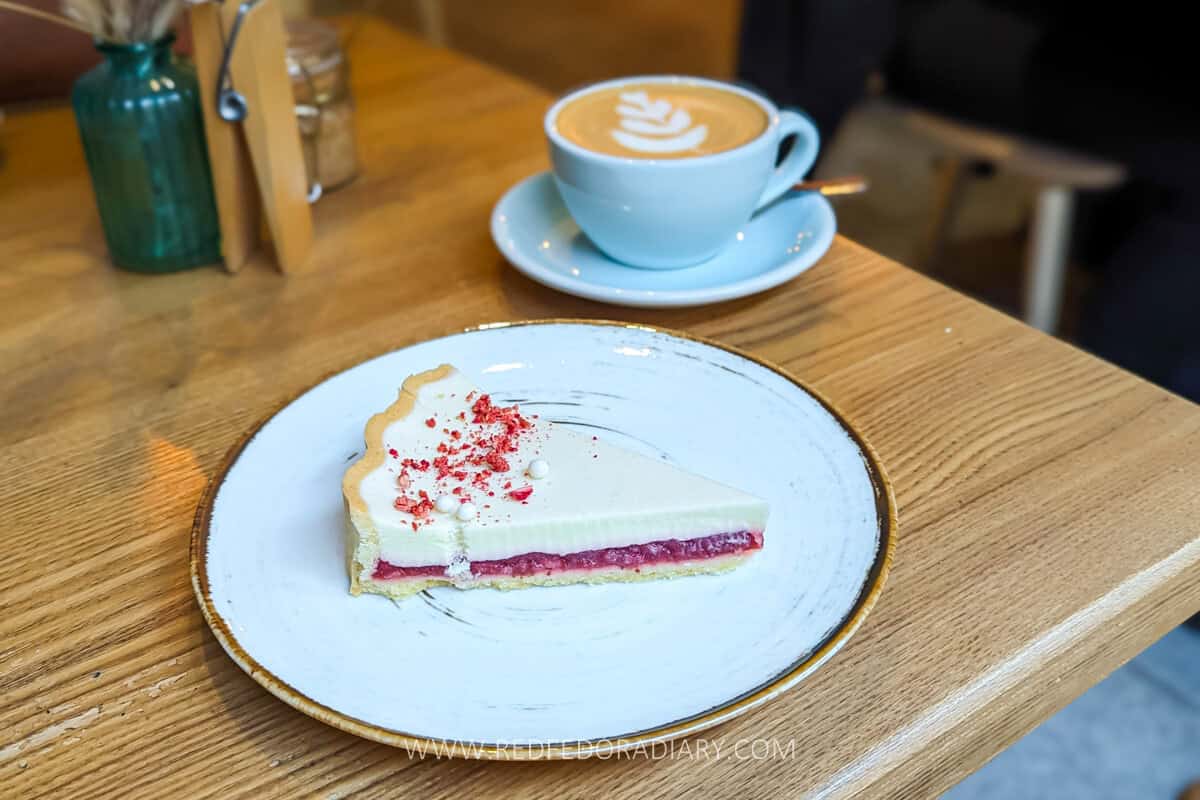
If you pop in for a dessert, they have a few menu choices and display them at the counter. My berry cake was light and delicious.
Visit the Silesian Museum
One of the most important spots on your list of things to do in Katowice should be a visit to the Silesian Museum housed in a former Katowice Coal Mine. The extraordinary range and quality of its exhibits, merged with the museum’s creative architecture and transformation of the underground chambers of the mine, make it one of the impressive Katowice tourist attractions.

When you approach the museum from the city center, the most visible item is the 40-meter-tall mine shaft hoist tower. Many such towers are spread throughout the Silesia region, and many still operate today.
This mine shaft heaved its last load of coal in 1999 when the entire complex was closed after working for 176 years and transporting over 120 million tonnes of black diamonds. Currently, it is repurposed as a viewing tower accessed with an elevator offering panoramic views of the city. Unfortunately, during my visit, the tower was closed.
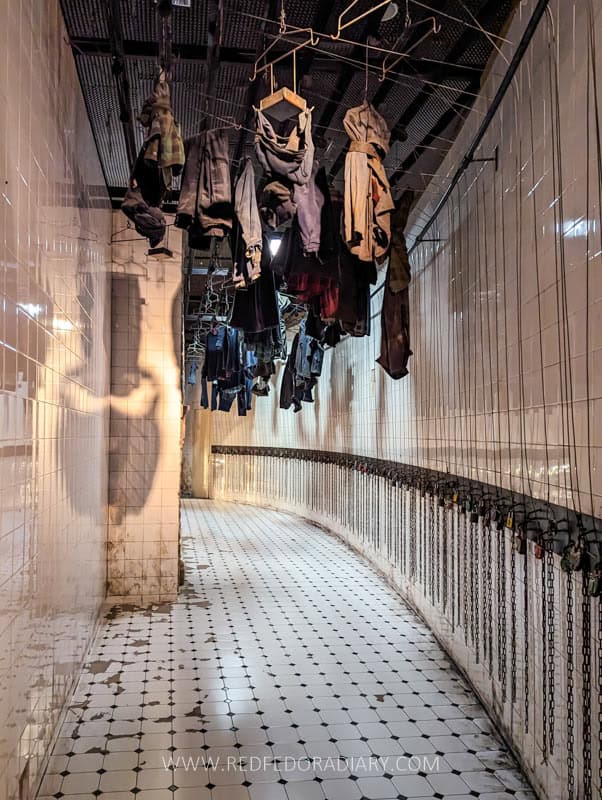

The Silesian Museum complex comprises six main buildings, both old and new, where various exhibitions (temporary or permanent) are held, and a few are open to the public. There’s also a restaurant and a gift shop. A ticket also includes visiting exhibitions in other buildings, so remember to check them out, too.
The main entrance of the prominent exhibition space is the largest glass building marked as G. The exhibitions are spread on four underground levels with a floor area of 25,000 sq. meters adapted from the former coal mine’s tunnels, workshops, and shafts.

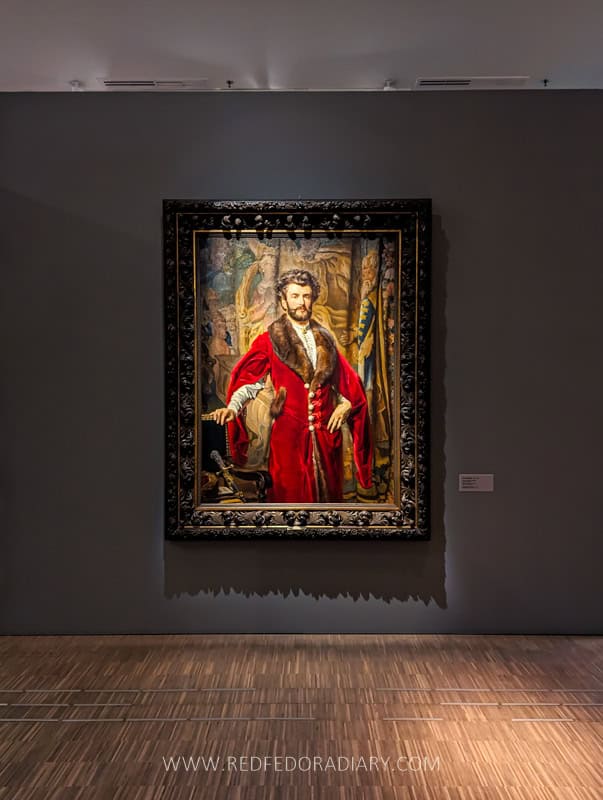
The main exhibition hall chronologically tells the history of Upper Silesia, from being part of Germany to its industrialization and from Soviet rule to the uprisings. There’s also a great collection of modern Polish art from 1800 to 1945, works of non-professional artists, and religious objects.
As you might already imagine, the Silesian Museum is massive, taking at least 1:30 to 2 hours to see everything and read the in-depth information boards in English.
Since the museum is open until quite late in the evening, I recommend coming here late afternoon to walk around on your own path calmly.
- Opening hours: Tue-Sun 10 am to 8 pm; Closed on Mondays
- Entrance fee: adults – 24 PLN; FREE on Tuesdays. More info.
See the Katowice’s own spaceship
From the Silesian Museum, walk around 10 minutes to the Spodek Arena, another architectural and cultural gem Katowice prides itself on. Part of the Katowice Cultural Zone, together with the Polish National Radio Symphony Orchestra, Spodek was opened in 1971.
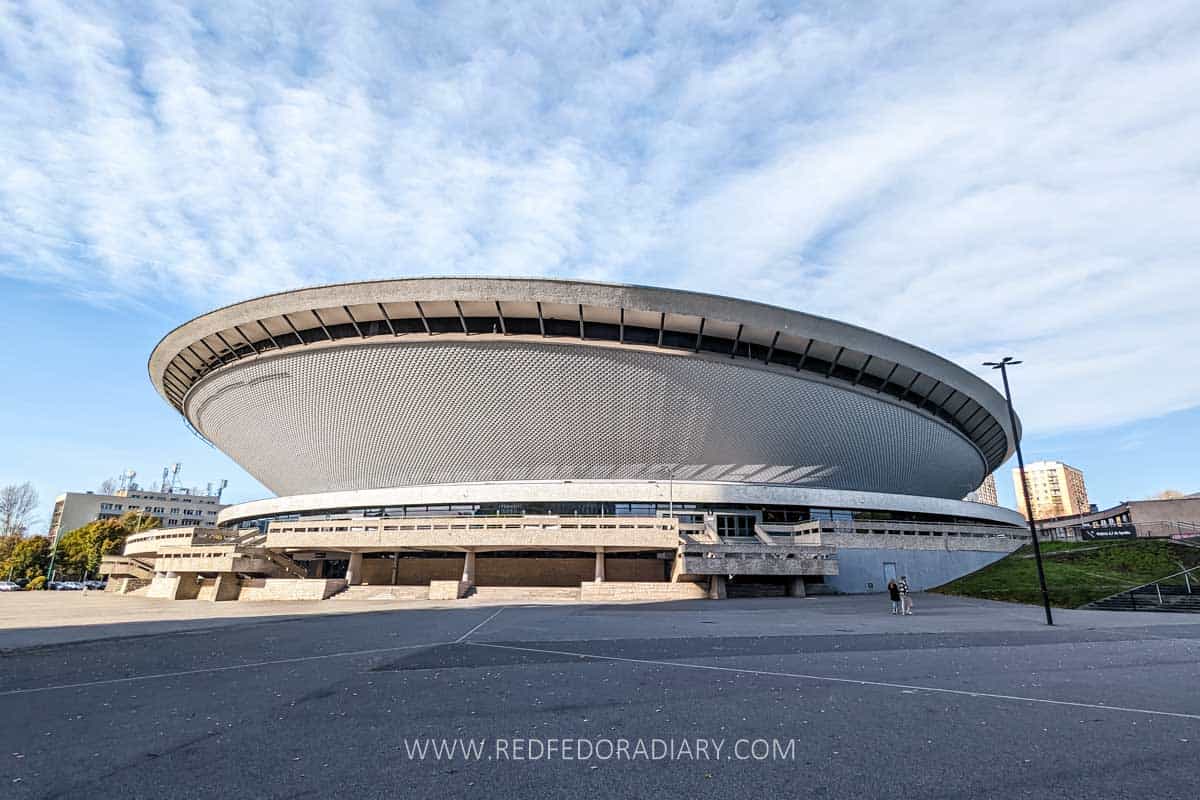
Being the second-largest indoor venue in the country of its kind (surpassed by Krakow’s Tauron Arena in 2014), Spodek looks like a spaceship about to take flight due to its unusual shape. And the word ‘spodek’ in Polish means ‘saucer’.
In addition to holding concerts and various events, there is an ice rink, a gyp, and a swimming pool inside.
You can tour inside this futuristic building if you contact the administration in advance and request it. Sadly, I could not schedule the guided tour due to many events held during my time in Katowice.
In summer, the eastern side of the Spodek features pop-up bars selling cocktails, beer, and snacks with deck chairs and music.
Admire the outstanding Silesian Insurgents Monument
The three Silesian Uprisings between August 1919 and July 1921 are engraved into the essence of Katowice and its citizens. The uprisings derived from locals’ who wished to split from the Weimar Republic (the name given to Germany between the times when the Imperial period ended in 1918 and Nazi Germany began in 1933) and unite with the Polish Republic; the revolts were somewhat successful.
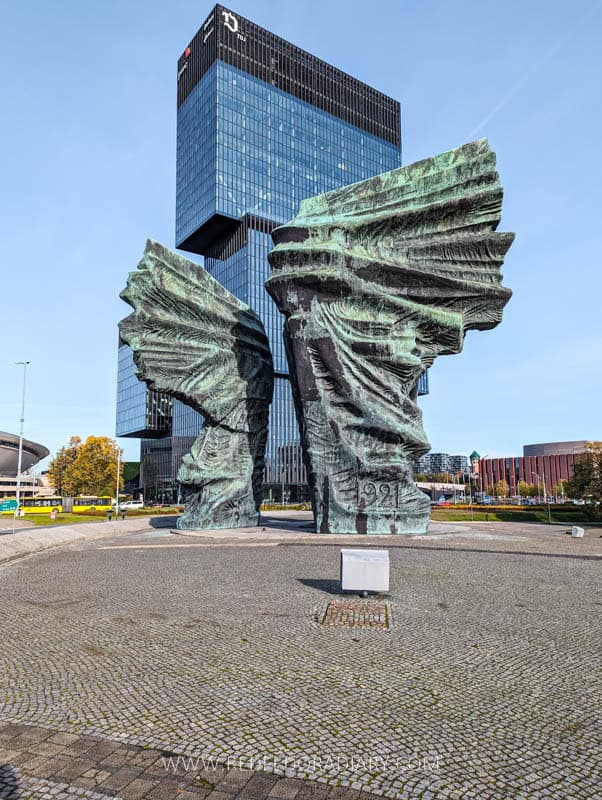
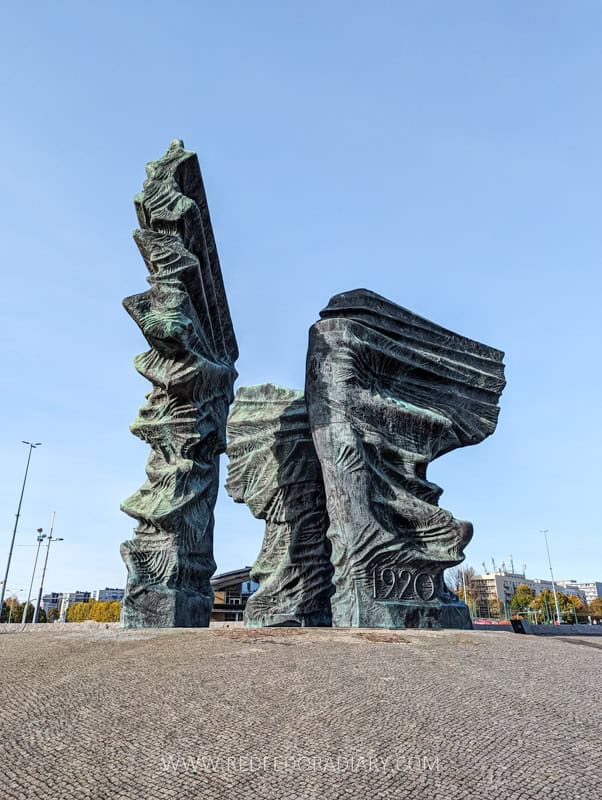
Pomnik Powstancow Slaskich, or Silesian Insurgents’ Monument, designed by Gustaw Zemla (sculptor) and Wojciech Zablocki (architect), symbolizes Polish nationalism that was unveiled in 1967 in a small park close to Spodek and Katowice Rondo, the gallery of fine arts.
It is a remarkable monument in shape and size, where three massive wings represent the three uprisings, and the names of the Silesian towns and cities where these demonstrations happened are also inscribed on the sculpture.
The monument’s placement on the elevated terrace makes it possible to go up close to it.
Spot Bebek statues all across the city
If Wroclaw has dwarfs and Gniezno has rabbits, Katowice has its statues honoring mythical Bebok, but compared to the others, they are even smaller, making it slightly hard to notice if you don’t know where to look. Therefore, spotting them is one of the fun and free things to do in Katowice, guaranteed for everyone to enjoy.
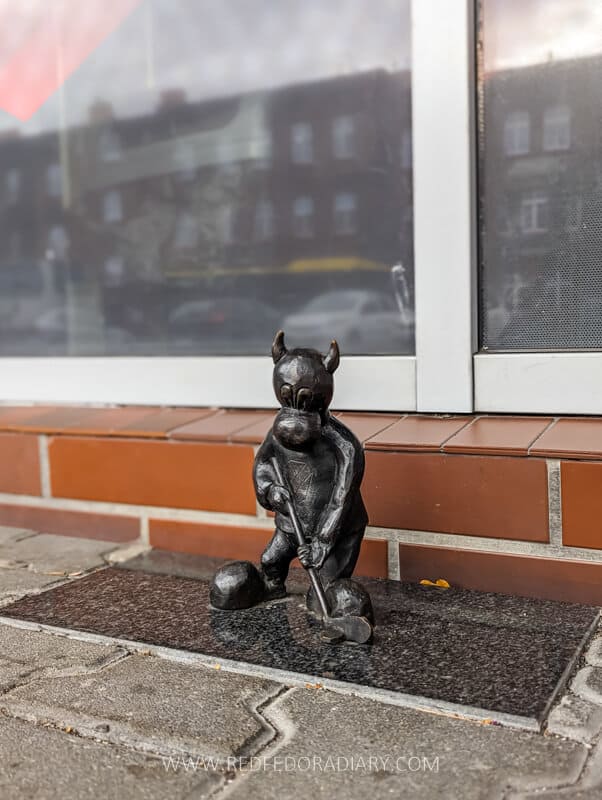
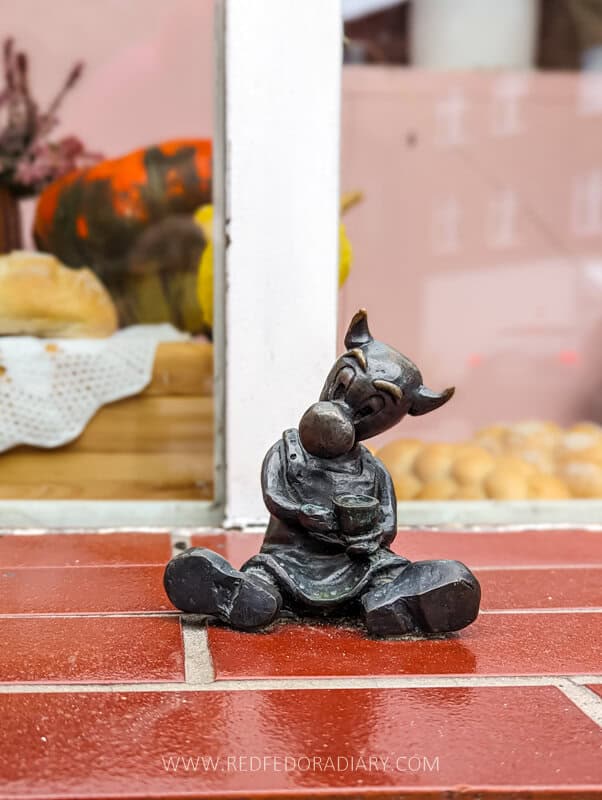
Bebok comes from old Silesian fairy tales and legends. Small in size, the Beboks are evil bogeyman figurines that would only trouble those shorter than them or of the same height.
The depictions of these goblin-type creatures often varied because the tales were passed down in oral storytelling instead of being written. Some stories would characterize them as a ragged, hairy man wearing a bobble hat and meant to scare children into compliance.
However, in the recent decade, Beboks were reimagined by Grzegorz Chudy, a Katowice Academy of Fine Arts graduate, who started incorporating them in his watercolor paintings of Upper Silesian landscapes and cities.
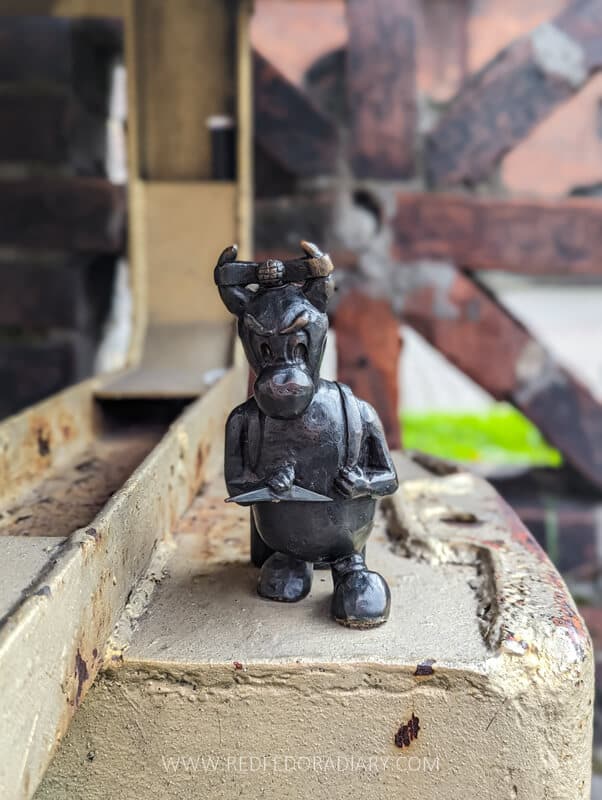
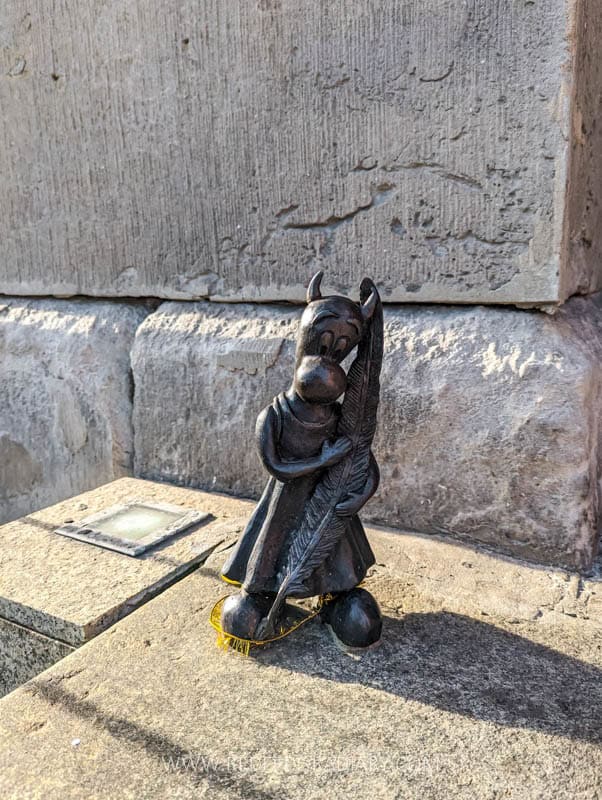
With the help of his daughter, he reinvented their personas and started showing them in positive ways, such as playing music or making snowmen. With their colorful, oversized shoes and innocent, big eyes, they became so popular among locals that these cute creatures now adorn various corners and spots of the city in miniature models.
You can spot them with the help of my Google Maps list provided above, which includes the locations of those I managed to hunt down during my time in Katowice.
Try Silesian cuisine
Silesian regional food is a subdivision of Polish and German, sharing similarities to the influence of its neighboring country. The most famous and typical regional meal of Polish cuisine here is the Rolada with kluski śląskie.
Rolada is a beef roulade filled with bacon, sausages, onions, and pickled cucumber. First, it is fried and then cooked in a sauce with onions and spices.
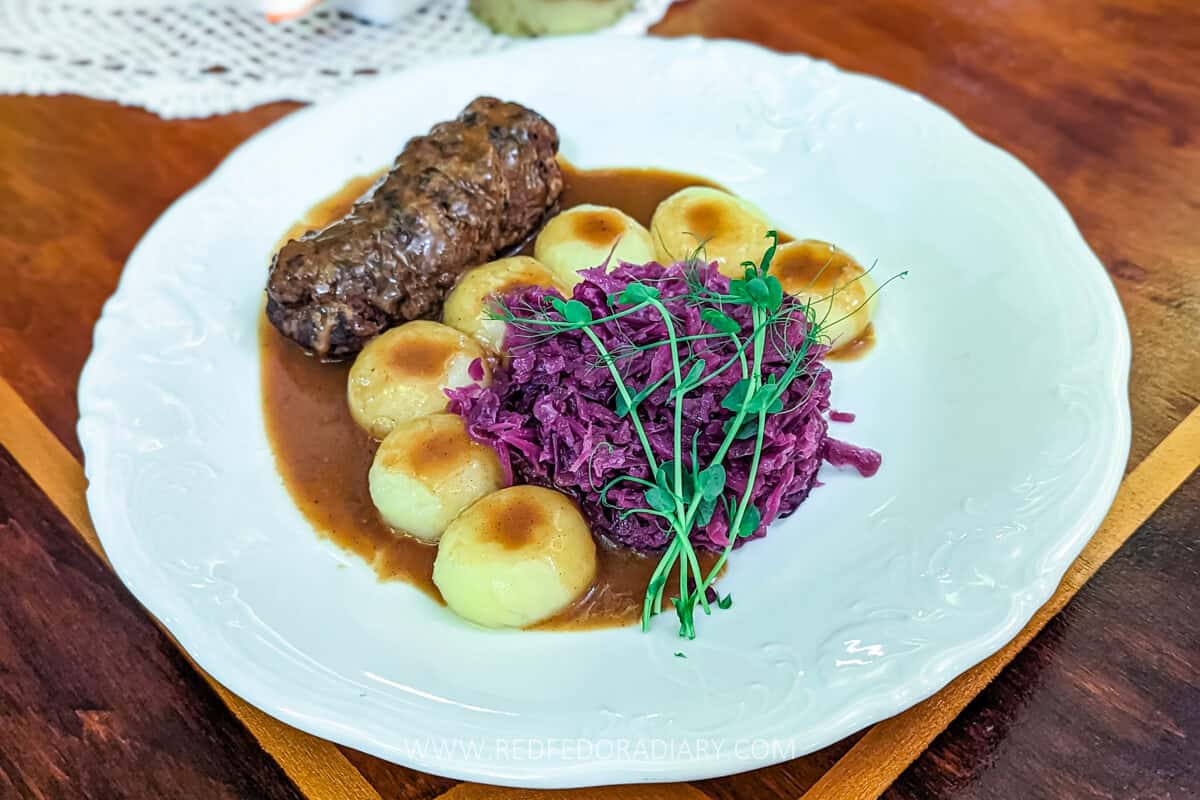
Kluski śląskie or Silesian dumplings, made from cooked and mashed potatoes mixed with eggs and flour, have a rounded shape and a small dent in the center.
As a side, the meal also comes with red cabbage fried lightly with onions and bacon and then mixed with gratified apples, salt, vinegar, and pepper. We tried it at Cafe Kattowitz.
It is a very different Polish food I have tried throughout my several visits to the country, and it reminded me of the Czech beef goulash I would eat in Prague as a student.
Visit the miner’s estate in Bogucice
Nestled close to the city, Bogucice is easily accessible by walking 10 minutes from the Silesian Museum or hopping on public transport.
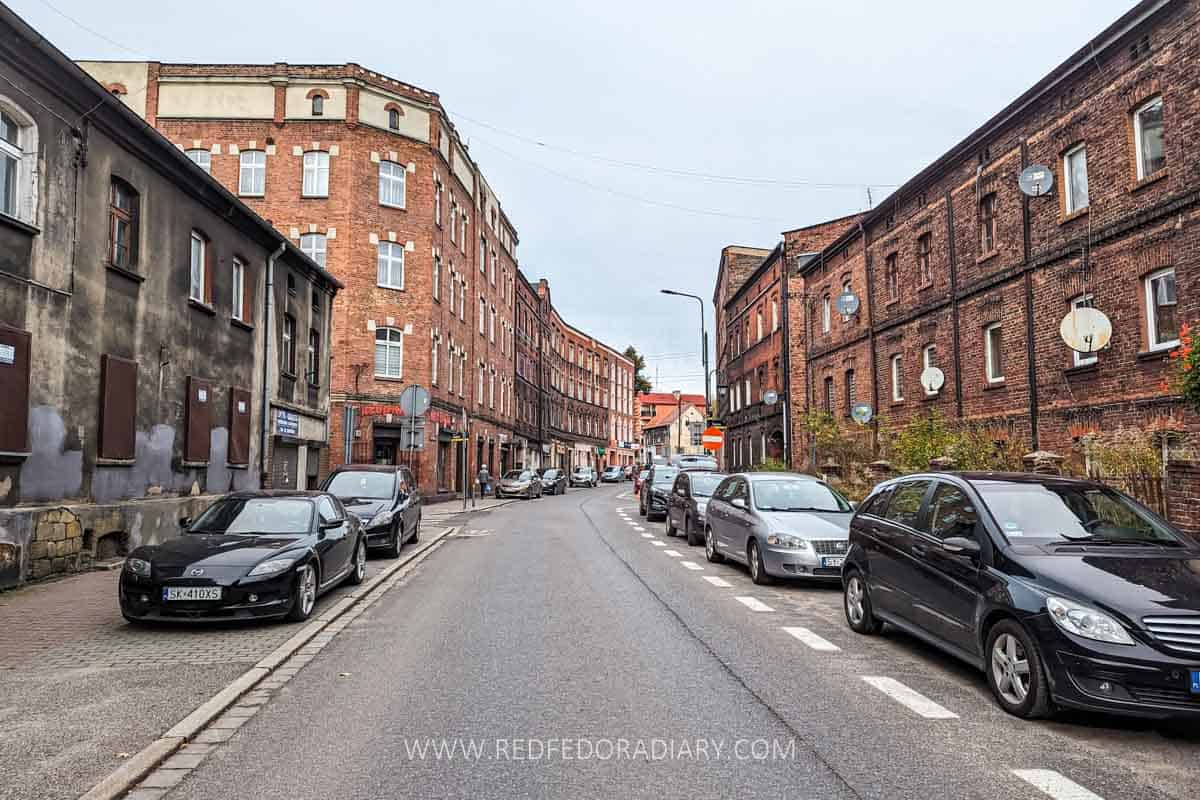
Bogucice is much smaller than the famed Nikiszowiec (see below) and has similar brick architecture tenant houses. However, compared to Nikiszowiec, it’s more run down and slightly unattractive. That said, it’s worth venturing here to see all three miners’ settlements representing the city’s history.
This settlement was custom-built for the workers of Katowice Mine, which today houses the Silesian Museum.
Start with the main Markiefki Street, filled with 19th-century brick houses with courtyards. On the ground floors of these buildings, you’ll find vintage-looking grocery shops and florists.
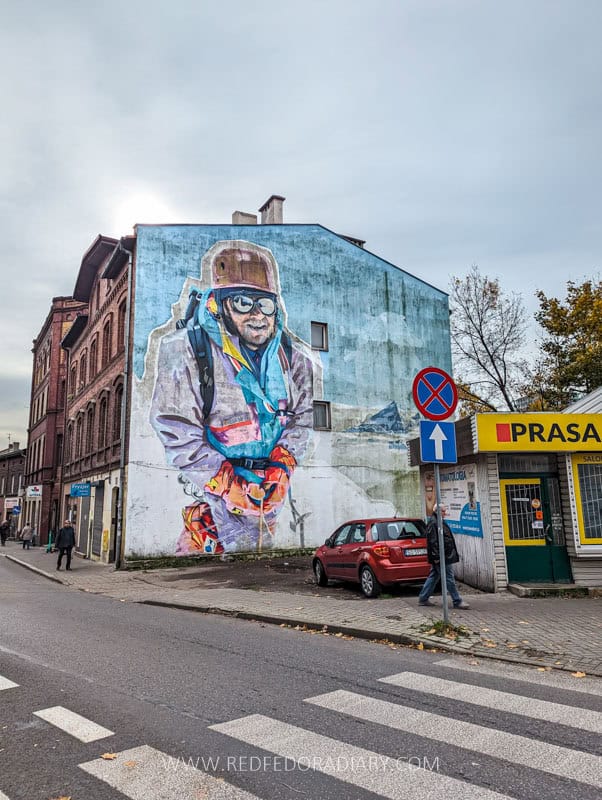

Continue walking until you come to the beautiful red brick St. Stephen Church, which was finished in 1894. Adjacent to it, you’ll find a mural honoring Jerzego Kukuczke, a Bogucice-born high-altitude climber.
If you turn onto Leopolda Street, you’ll see another massive brick building that used to be an orphanage run by nuns from 1886. During WWII, children and nuns were deported to Germany, and after the liberation, the Soviets turned this building into a special facility for slightly disabled children. Today, nuns run an Educational Center for youth and a kindergarten.
Spend the half day roaming through Nikiszowiec district
Distinctive brick buildings with red window frames and flower mosaics on the walls make Nikiszowiec, a mine worker’s house settlement, inevitably linked to Katwoice’s past.

The estate, built between 1908 and 1918 by the metallurgical and mining company Georg von Giesches Erben, was to accommodate Wieczorek (formerly Giesche) coal mine workers.
The complex has six tight, four-sided, three-floor blocks with massive shared inner courtyards called ‘familoki’, and together with the nearby Giszowiec (more on this below), both neighborhoods are the best examples of such architecture in Europe.
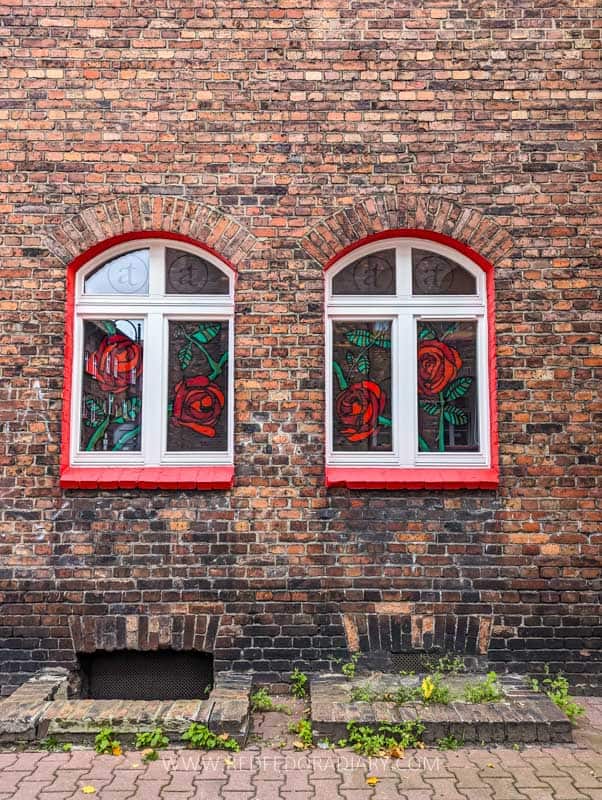

Characterized by its uniform style and narrow streets bound by lovely arcades, the neighborhood was meant to house 1,000 workers in this self-sufficient estate with shops, a church, restaurants, schools, laundries, a post office, a swimming pool, a police station, and bread-baking ovens. Basically, everything workers and their families would need.
Wandering through the buildings is one of the unique things to do in Katowice, as the complex has stayed the same since WWII, giving an excellent opportunity to glimpse at the city’s industrial heritage in the most authentic way.
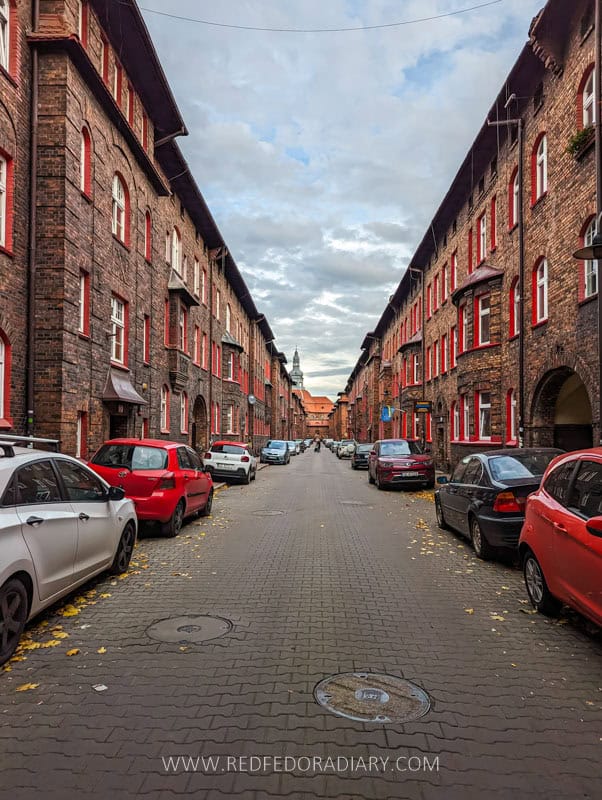
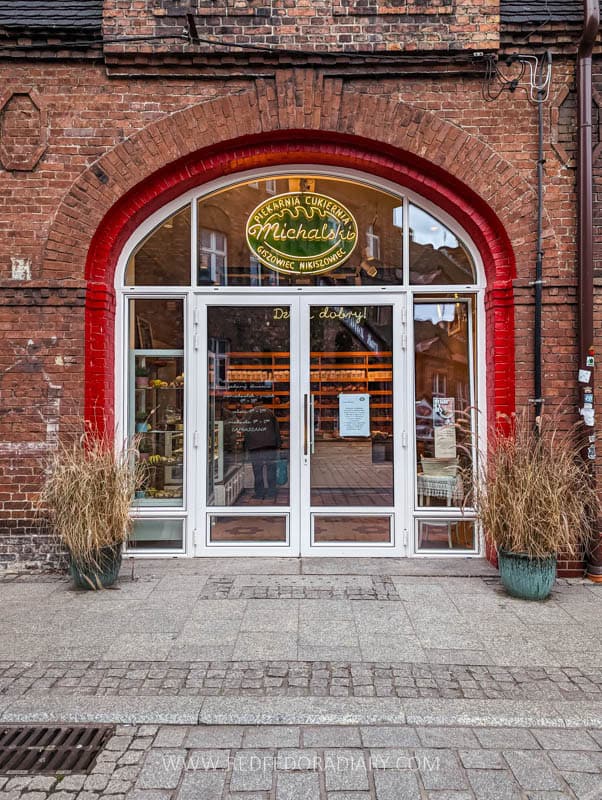
Even though it is safe to roam around, remember that it is still a residential place where people live, so be mindful of their personal spaces and be cautious where you walk or stick your camera.
Located only 7 km from Katowice’s Rynek, frequent buses depart to Nikiszowiec, depending on where you want to start your wanderings.
A bus No.930 will take you directly to the center of the estate, but I’d recommend taking the M101 bus to Wilhelmina Zespół Szkół stop to start from a visit to Wilson Shaft Gallery (more on this below) and then walk about 15 minutes to get to the center of the complex.

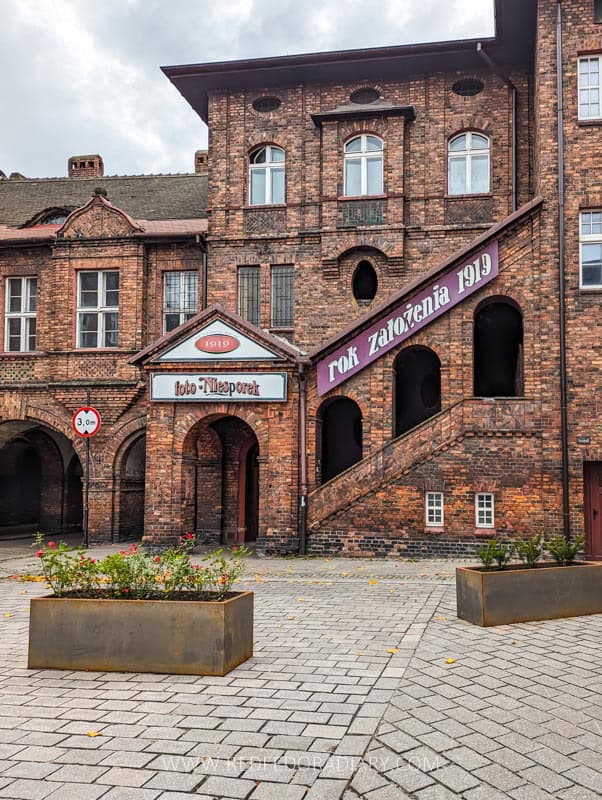
Nikiszowiec is a small area easy to explore on foot. You can wander through it on your own or book a tour with a local to understand and know more about the neighborhood.
The most famous building here is Post Office 16, with its two stripes of rose mosaic on the exterior inspired by local traditional Silesian dress embroidery. The Roman Catholic Parish of St. Anna, blessed in 1927, is next to it.
Primary school No.53, opened in 1911, still functions as a school. Back in the day, it had three buildings: one for boys, one for girls, and a third residential building that linked them.
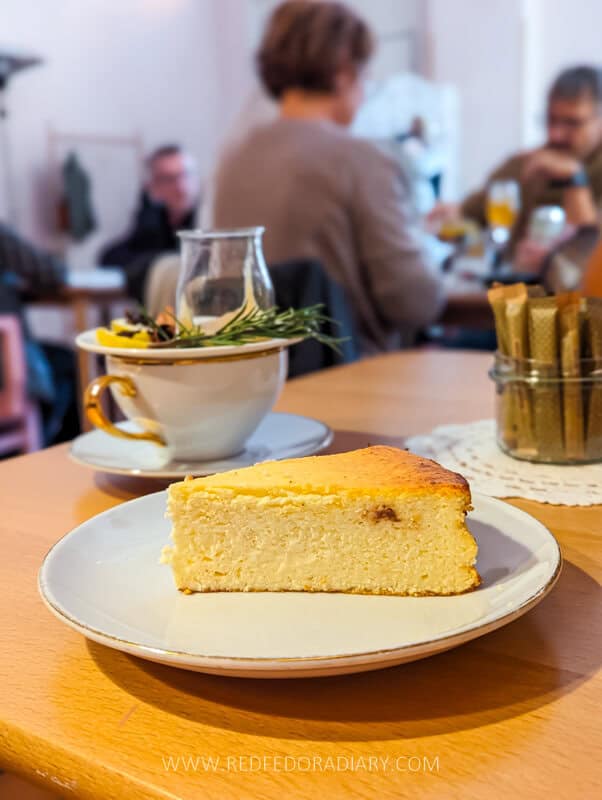

Don’t miss out on visiting the Industrial Ethnography Museum (more on this below), where you see recreated Nikiszowiec apartments. And when you get hungry, have lunch or a coffee break at Slaska Prohibicja, a restaurant housed at the old miners’ refectory, or a cute Cafe Byfyj.
Notice various decorations on the facades when strolling through buildings. Apparently, each building was designed to be slightly different from one another so that tired miners wouldn’t go into the wrong house after a long shift. And remember to look for tiny beboks in the neighborhood.
See how miners lived at the Industrial Ethnography Museum
This museum is so unique and interesting that it deserves a separate listing. The branch of the Katowice Historical Museum, it showcases the everyday lives and stories of Upper Silesia’s working class, primarily miners, through its collection and artifacts from the early industrial development of the mid-19th century to the 1960s.

Here, you can walk through a small room that’s a recreation of the typical Nikiszowiec worker’s house, displaying household items, bathroom sinks, beds, kitchen utensils, etc.
The most fascinating for me was the big room devoted to laundry services and techniques and a massive wall of bar soap mounted on it. English information boards explain how women washed their clothes and tell the history of these bar soaps.
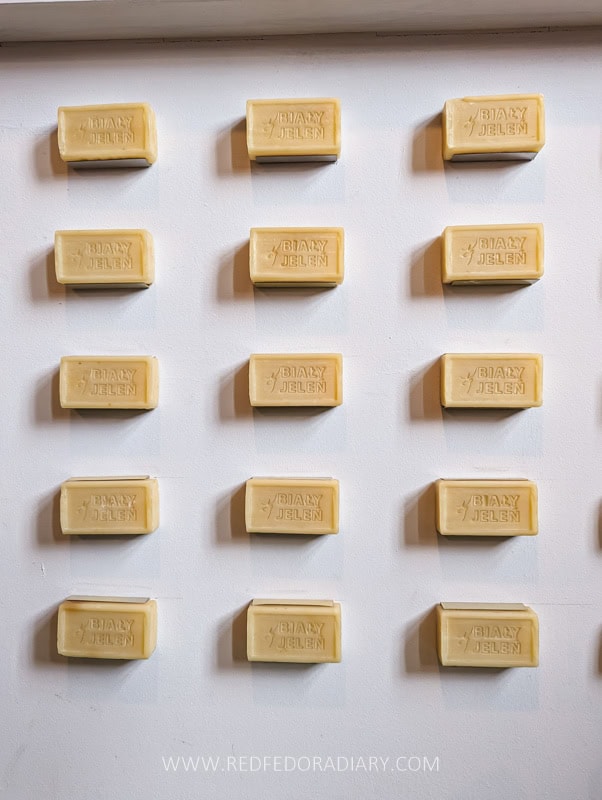

The embroidered linen tablecloths and kitchen towels hanging on the dryer are charming and beautiful.
- Opening hours: Tue-Fri 10 am to 6 pm; Sat 10 am to 4 pm; Sun and holidays 11 am to 3 pm; Closed on Mondays
- Entrance fee: adults – 15 PLN; FREE on Tuesday (permanent exhibition only). More info.
Admire art at the Wilson Shaft Gallery
Located 15 minutes from the center of Nikiszowiec, Wilson Shaft Gallery is a modern art gallery housed in the bathhouse and pithead building of Wieczorek mine’s old Wilson shaft, which dates back to 1918.
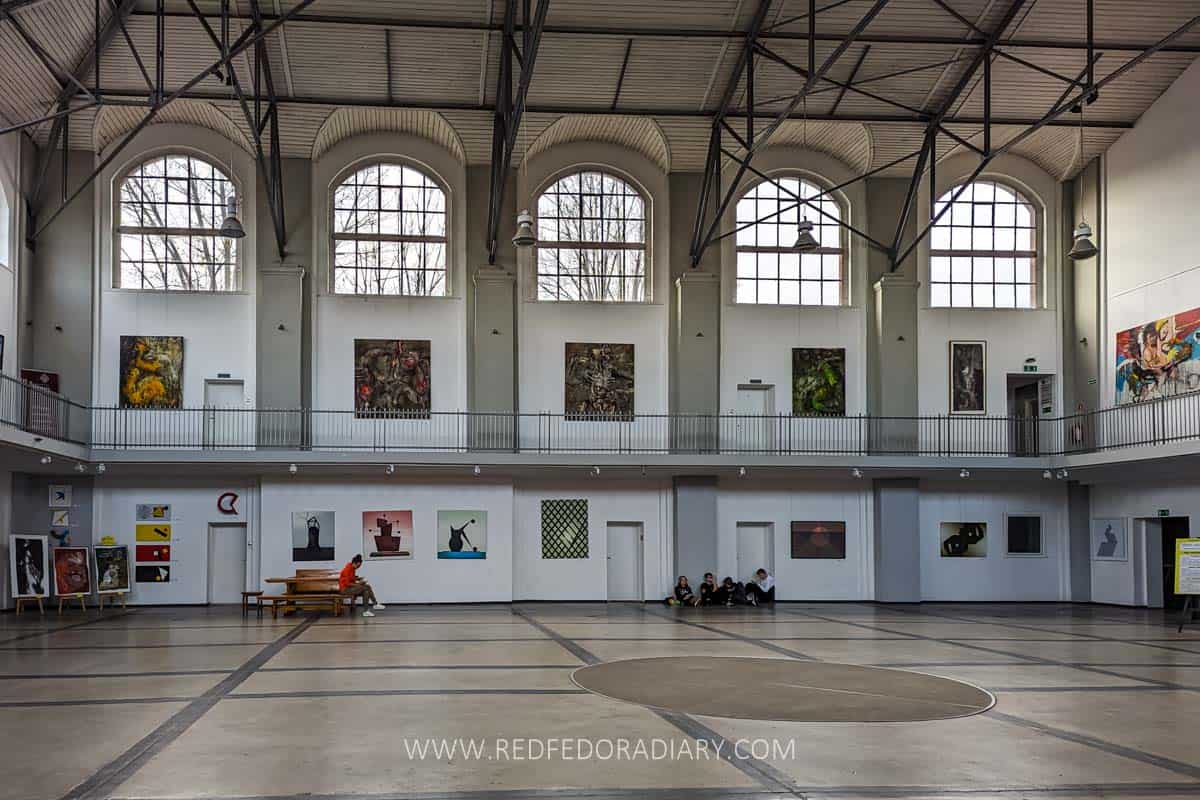
As mentioned above, we started our Nikiszowiec trip from this gallery to explore the second miners’ settlements afterward.
The ragged mineshaft, where mining started in 1864, is still visible in ruins behind the gallery buildings that stopped its operation in 1997. Aquaried by the ‘Pro Inwest’ company and repurposed into office spaces and exhibition halls, the Wilson shaft now features outdoor sculptures that contrast the industrial appeal.
The gallery space includes an impressive 2,500 square meters split into three halls showcasing various art from local and international artists.
- Opening hours: everyday from 9 am to 7 pm
- Entrance fee: FREE. More info
Walk to Balkan Narrow Gauge Railway
If you follow my route, first visit the Wilson Shaft Gallery, followed by the walk through Nikiszowiec, and then continue to the third miner’s settlement called Giszowiec.

On the way, you’ll find Balkan Narrow Gauge Railway and Pulaski Shaft Complex, just a few minutes walk from the end of Nikiszowiec settlement.
There is little information on the railway, and based on my research, the narrow-gauge railway linked Giszowiec with Nikiszowiec and the nearby district of Szopienice, a convenient option for miners and their families who needed transportation to work, shops, and schools.
Electric locomotives pulled small green wagons and stopped at various shafts, including the Carmer, later renamed Pułaski, Nikisch (Poniatowski), and Richthofen (Wilson). The railway was free of charge and ran 23 times per day on workdays and 19 on Sundays and holidays from 1914 until 1977.
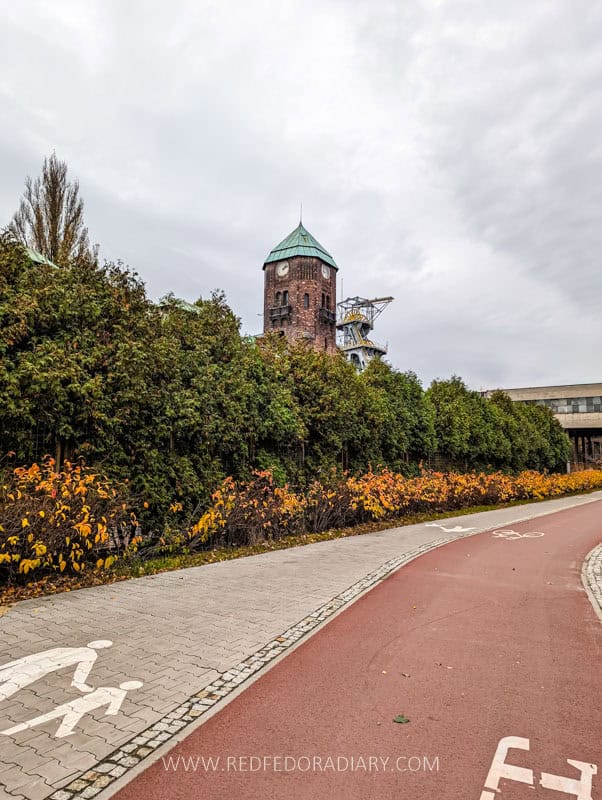
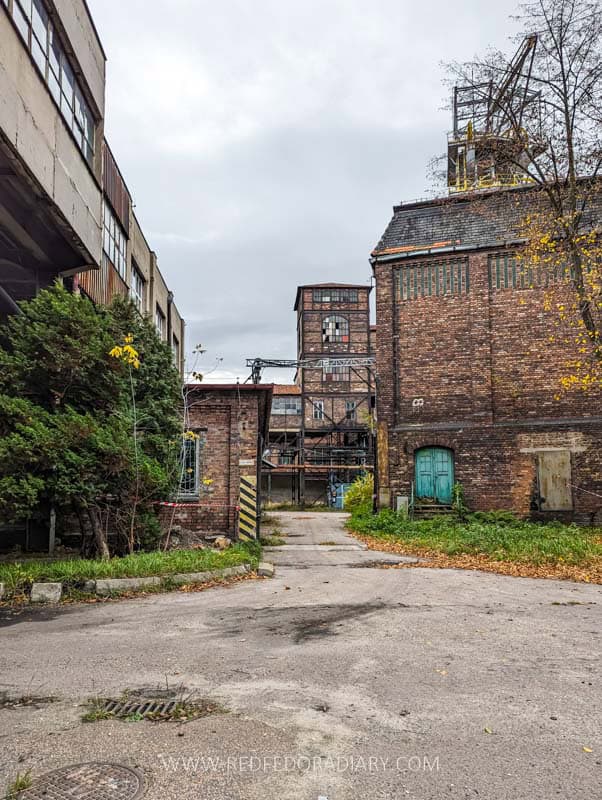
The railway was nicknamed Balkan Express in connotation to the luxury train connecting Berlin to Constantinople (current Istanbul, Turkey) that was also launched around that time.
Sadly, most of the railway was demolished after two new car routes crossed the Balkan route. Only a tiny fragment with the green carriage can be seen at the entrance of the Pułaski Shaft.
Explore Giszowiec – the third neighborhood of miners
Just around 2 km from the Blakan railway lies another miner’s settlement, Giszowiec, which is very different from the abovementioned Nikiszowiec and Bogucice.
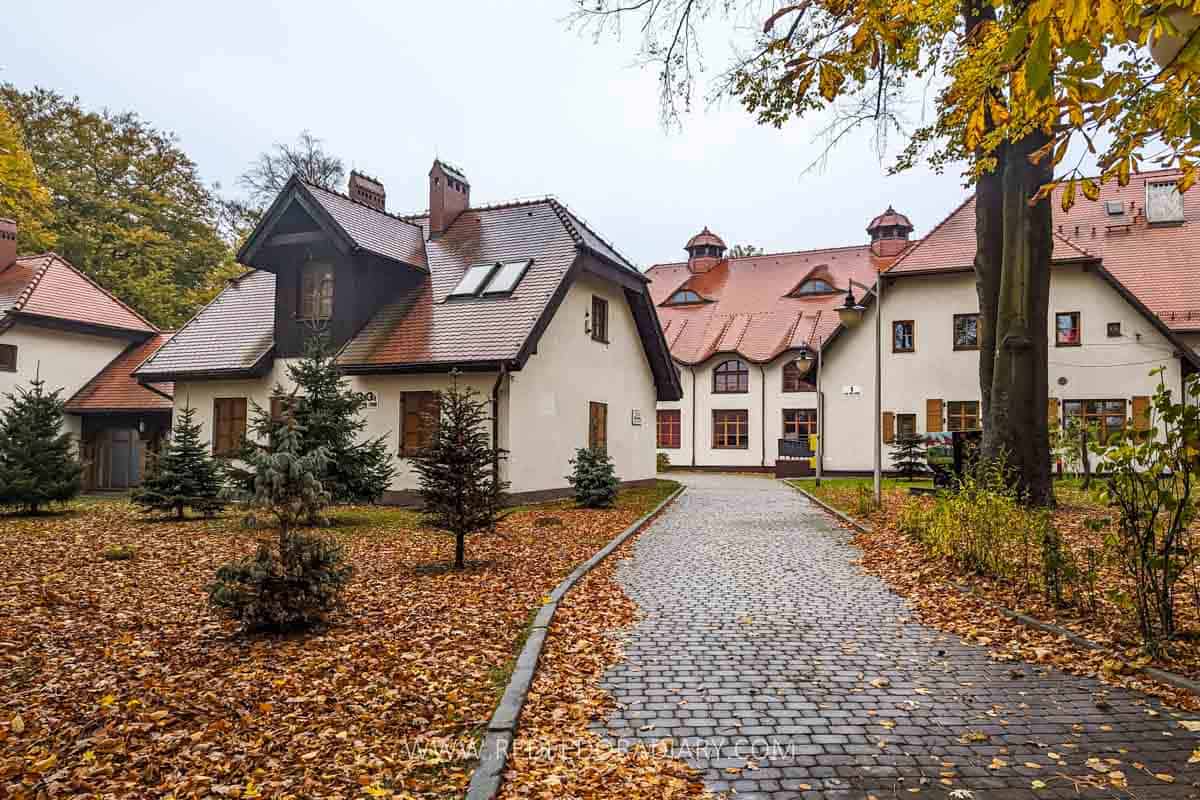
If you are up for a walk, the road passes by leafy forests and natural landscapes until you join a highway with a pedestrian sidewalk.
Constructed in 1906, Giszowiec housed administrative workers of the mines, such as bookkeepers, engineers, clerks, managers, etc. If the first two settlements feature packed brick buildings, the houses here are villas and cottages with their own gardens.
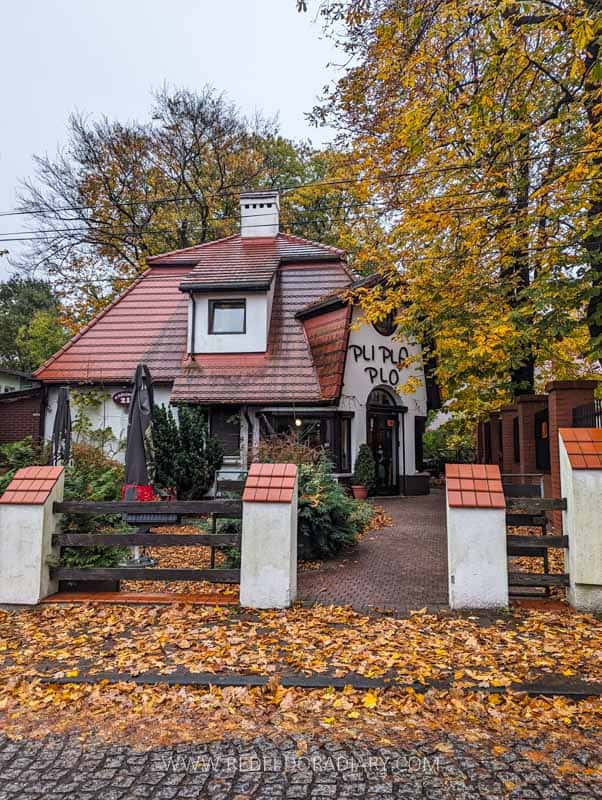
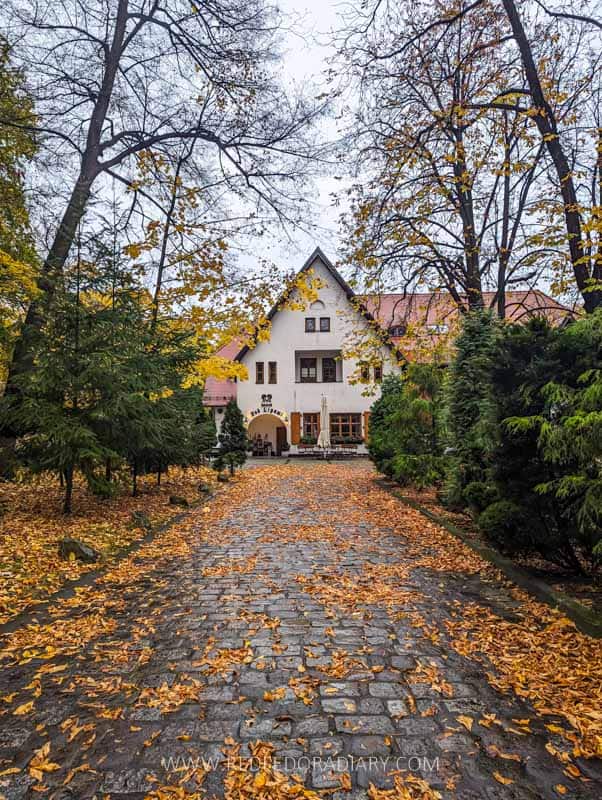
Unlike the other two, Giszowiec is green and leafy, with pedestrian paths and wide streets. Start your exploration from Gościnna Street to find some of the area’s most iconic buildings, including an old inn designed as a cultural center.
Most of these cute white villas and cottages have dormers and gabled roofs and are of German style. The same architects who designed the neighboring Nikiszowiec – Georg and Emil Zilmanns – planned this settlement too.
During our visit, it rained heavily, preventing us from wandering further into the settlement and seeing the red-brick water tower. However, I have still included it in the above map for your information.

The neighborhood is well-connected with public transportation, and depending on where you end your exploration, you can rely on the bus navigation steps in Google Maps to find the right bus number to Market Square.
We returned to the Radosna and Gościnna streets intersection and took bus No.920, which also passes by Silesian Musem and Spodek.
Seek for retro neon signs
If you are looking for things to do in Katowice at night, looking for retro neon signs in the streets is so much fun. Almost invisible during the day, these historical neon signs flash as the sun sets and tell one more heritage story of the city.
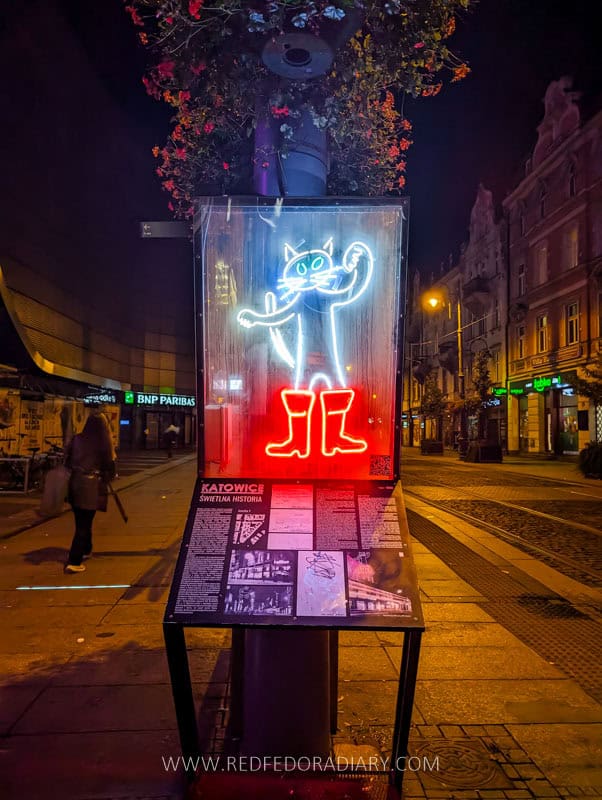
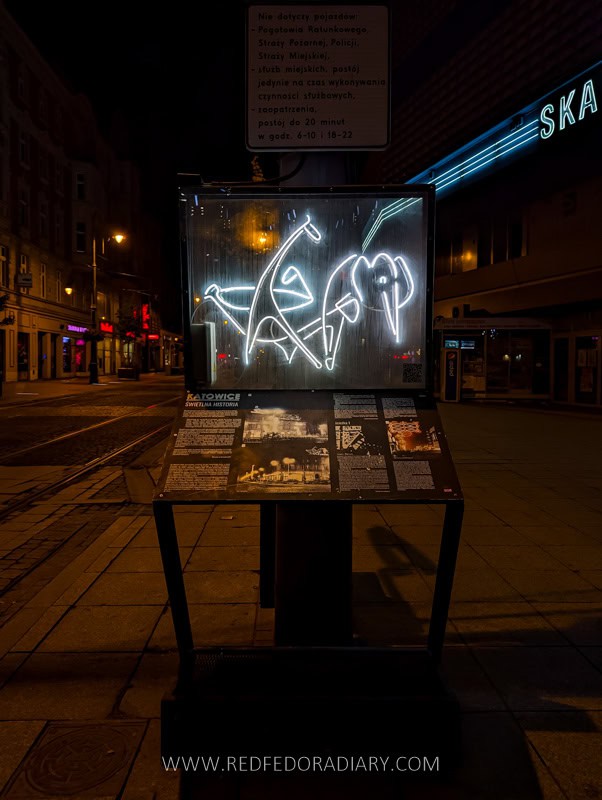
In the years of the Polish People’s Republic, Katowice, much like Warsaw, started beautifying its streets with colorful and flashy neon signs totaling almost thousands of them scattered all over the city.
Since 2010, Katowice has had nearly a hundred new and reconstructed neon signs, both commercial and artistic forms of illuminating advertisements. The information boards below the signs tell you their story and where they were placed, with archival photos added to the boards for easy visualization. You can find these historical signs at 3 Maja, Dworcowa, Slawowa, Mariacka, and Świętego Jana.


However, have your eyes pierced for other neon signs across the city center. I especially loved Zachod Sluonca, or Sunset, neon that reflected its purple colors in the flowing river.
Go on day trips from Katowice
With the proximity to a few cities and historical landmarks, you can easily go on day trips from Katowice to Krakow, Auschwitz, Wroclaw, and Częstochowa, to name a few.
Visiting Auschwitz-Birkenau Memorial, the deadliest Nazi concentration camp, is more accessible by renting a car as it’s only 40 km away from Katowice, taking around 35-50 minutes, depending on the traffic. Buses frequently depart daily from 8 am from Katowice’s main bus station and will drop you off at Oświęcim train station, 1.5 km from the museum entrance. You can read my detailed Auschwitz travel guide, which gives information on how to visit it both from Krakow and Kawotice.
With so many things to do in Krakow, I highly recommend spending at least a night here, but if you don’t have much time, you can pack your Krakow itinerary with the most important historical landmarks.
If you want to see another charming town in Poland, consider visiting Wroclaw, a 2-hour train ride from Katowice. You can do many things here, but the city is mainly famed for its nearly 600 small dwarf statues scattered across the city. See the train schedule here.
Where to stay in Katowice
For easy access to the most Katowice attractions, stay somewhere close to the train station or the Rynek. This area also has plenty of supermarkets, cafes, and well-connected public transport.
Most of Katowice’s accommodation options are apartments, with a few hotels. We stayed at a CityCenterApartment/M2/7, 2 minutes from the train station and 5 minutes from 3 Maja Street.
You can check other apartments and hotels in Katowice on Booking.com and choose the one that suits your budget and needs.
Katowice travel tips
How to get to Katowice
Katowice Aiport serves local and international budget-friendly airlines across Europe and even the UAE.
We traveled to Katowice by train from Poznan, taking 4 hours to reach the city. If you are already visiting other cities in Poland, you can visit Katowice from Warsaw, Krakow, Wroclaw, and others with a well-connected train system. If you are somewhere near Poland, you can also opt for trains from Budapest, Prague, Vienna, or Bratislava.
When flying into Katowice Airport, take the AP bus that runs 24 hours every 30-60 minutes, with the final stop being the Katowice railway station. The time to reach the center is around 45 minutes, so buy a 90-minute ticket, costing 6.60 PLN.
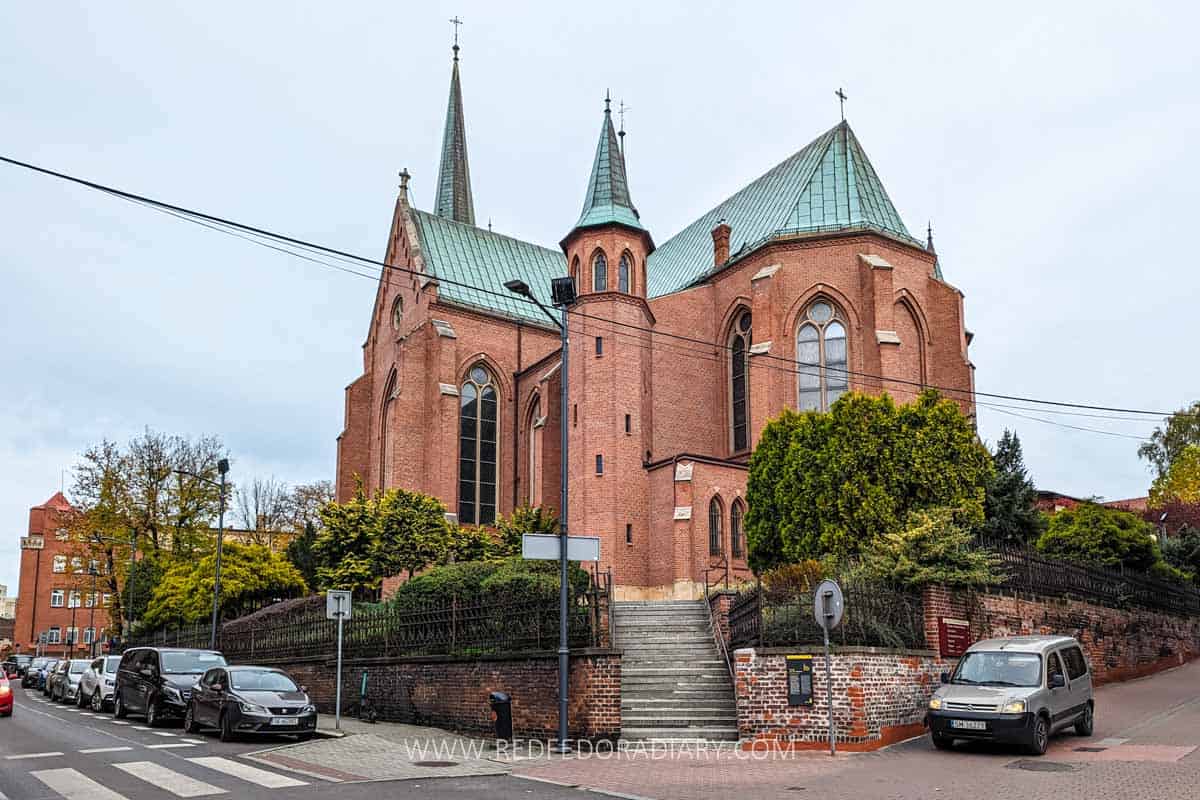
How many days to spend in Katowice
Katowice is a great destination to spend a few days in and a day trip option from Krakow. If you plan your days well, two full days should be enough to see all the above Katowice attractions.
However, if you decide to go on day trips from Katowice, add one or two depending on which places you want to explore.
Navigating public transport in Katowice
We walked everywhere to explore the city except for Nikiszowiec and a return trip from Giszowiec to the center. The bus and tram networks are linked to Google Maps, so it is straightforward to navigate and determine which number to take when you put your locations.
Katowice has timed paper tickets. Therefore, you must know the approximate bus journey time to purchase a corresponding ticket. Most bus and tram stops have ticket machines, but some don’t.
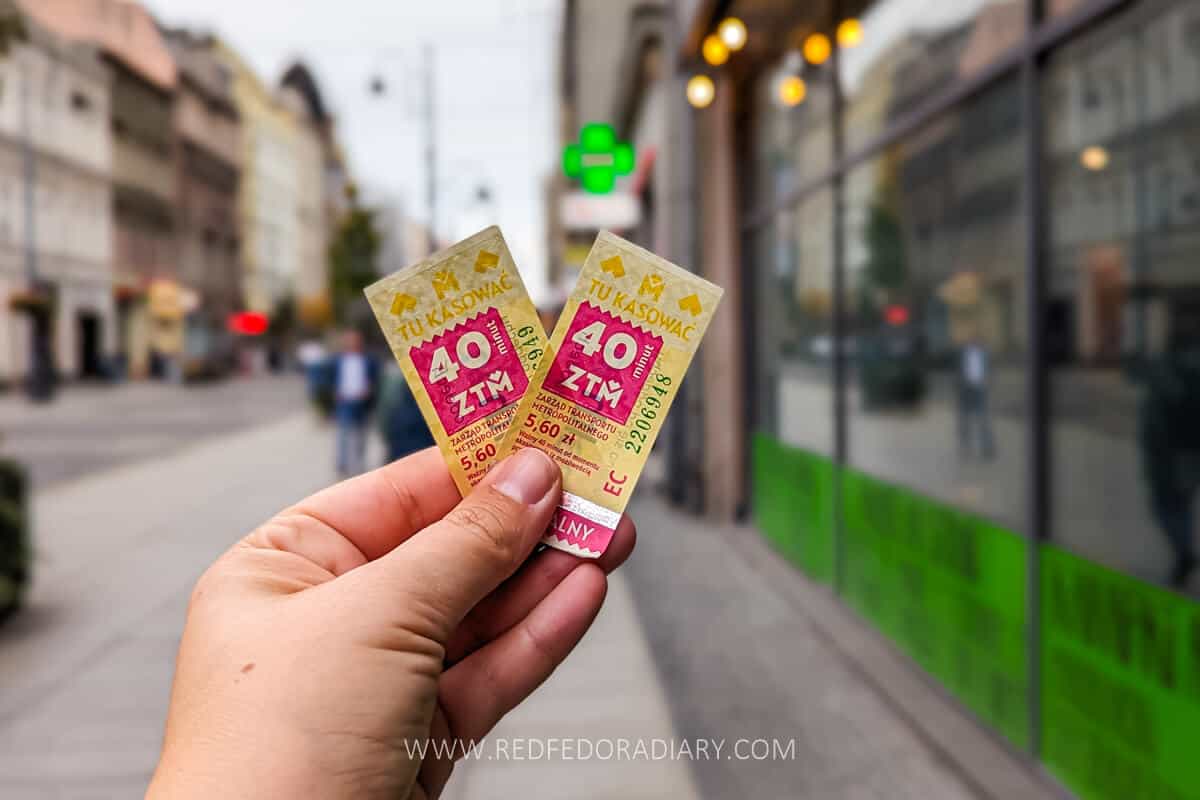
During our time, the machine was not taking credit/debit cards, while a person in front couldn’t get the machine to take his banknotes either. In that case, look for a kiosk at the Skarbek building on the side of 3 Maja Street that says Bilety Jednorazowe. You can pay with cash or a card here.
During our visit and when writing this post, the tickets cost 4.60 PLN for 20 min, 5.60 for 40 min, 6.60 PLN for 90 min, and 12 PLN for a full day.
The tickets need to be validated once you board the bus or tram, and that’s when the timer of your ticket starts.
When traveling outside the city center, primarily to the Nikiszowiec and Giszowiec neighborhoods, I suggest buying tickets in advance and keeping them whenever you decide to return to the center.
How expensive is Katowice
Katowice is relatively inexpensive and very budget-friendly among all the cities I’ve visited in Poland. Food and drink prices, both in the groceries and cafes, are much lower than in famous cities like Krakow or Warsaw. Accommodation prices were also lower compared to Poznan, for instance.
